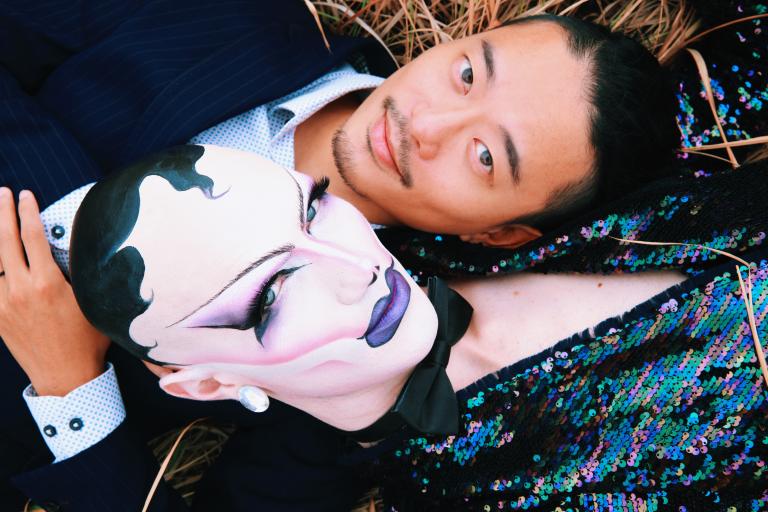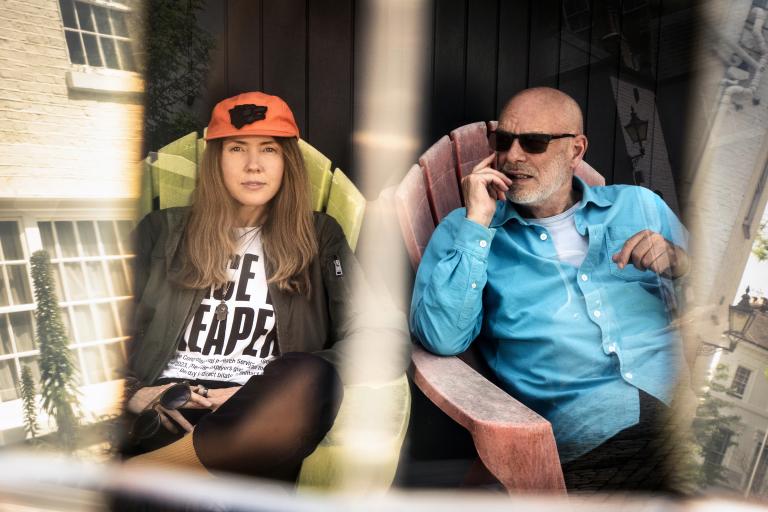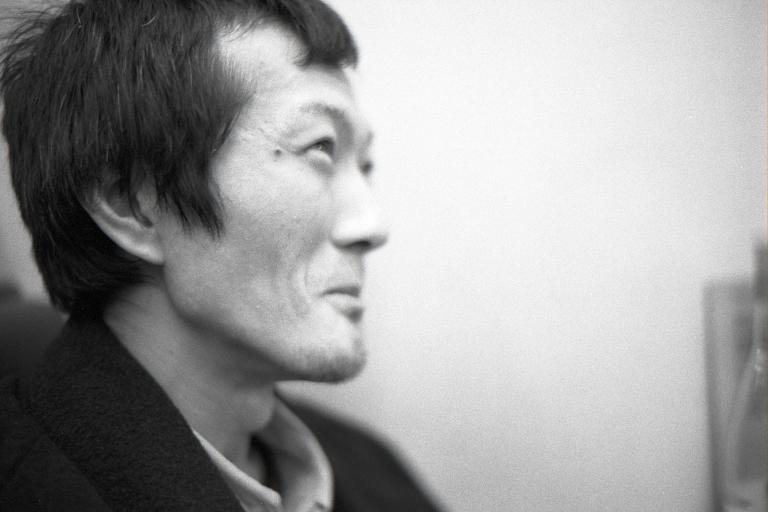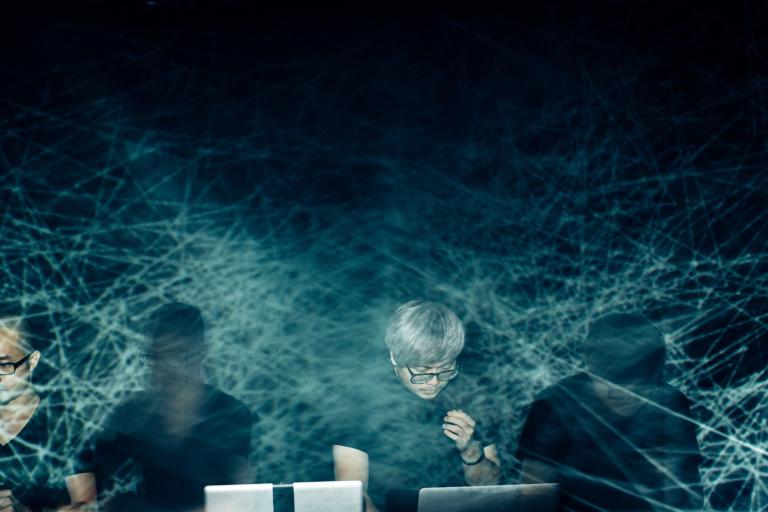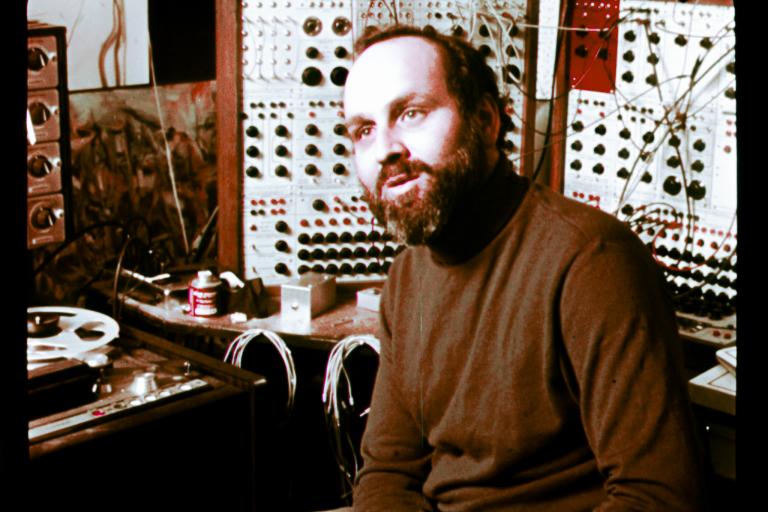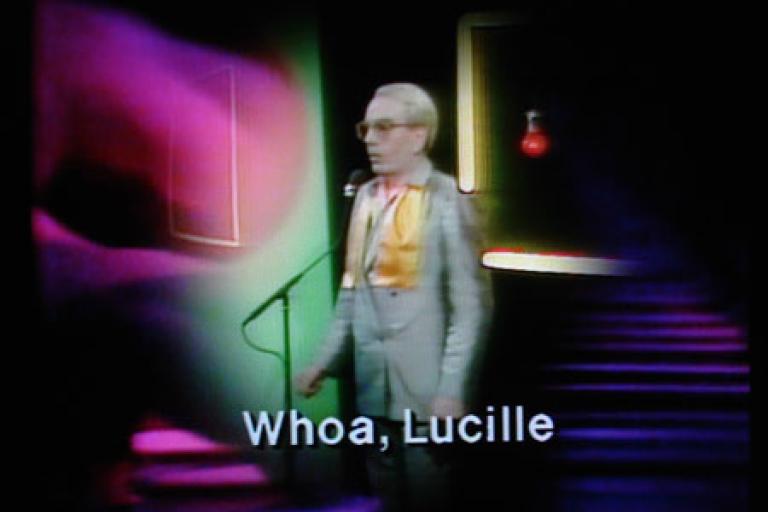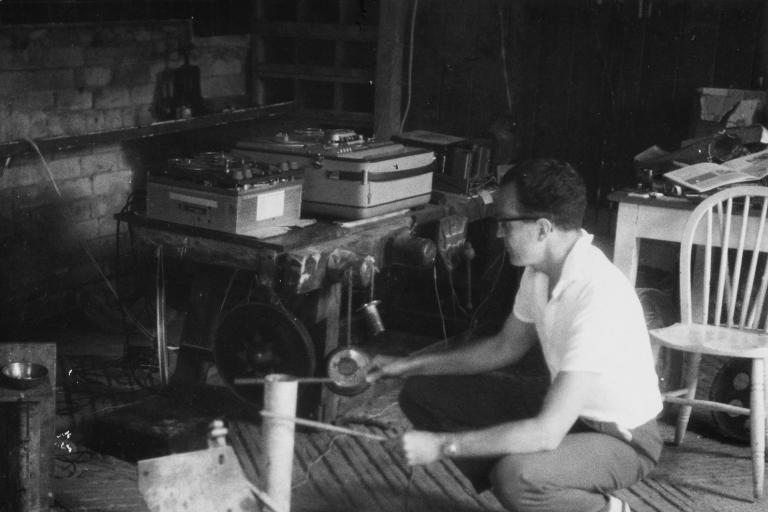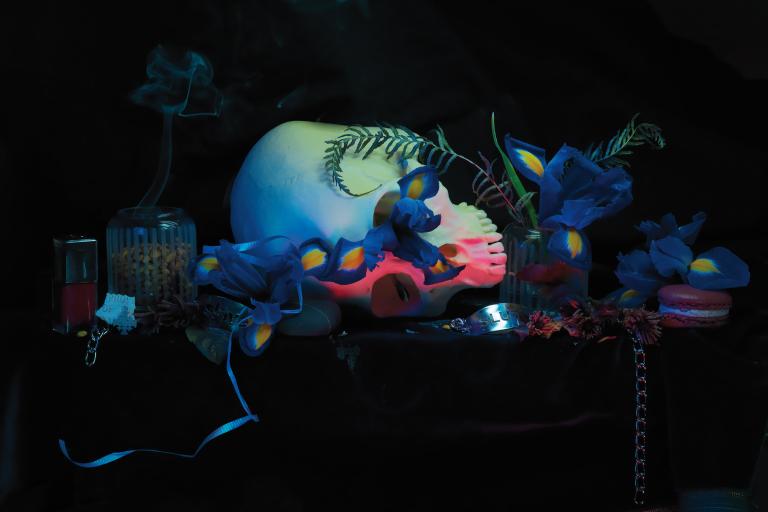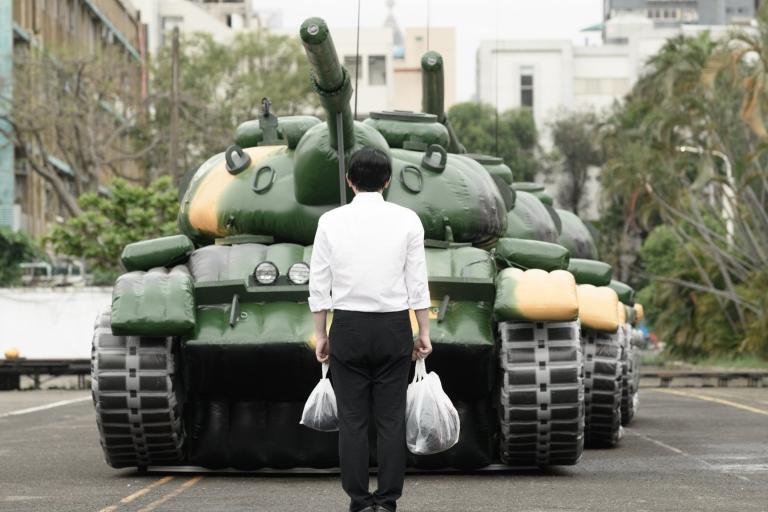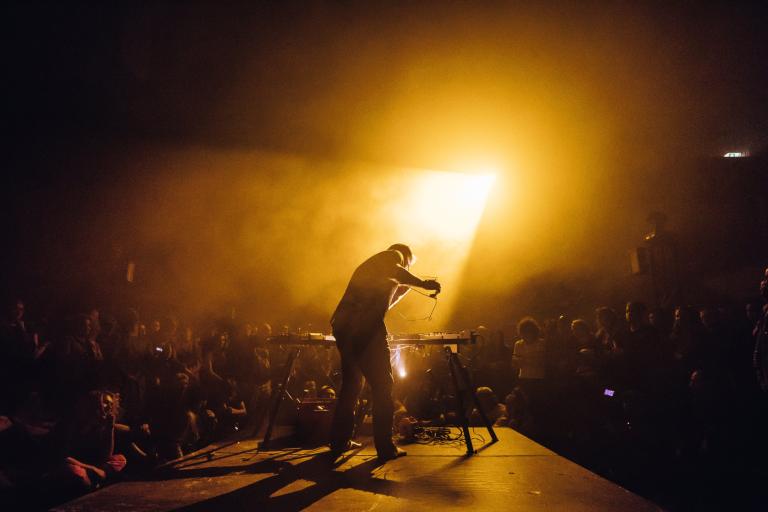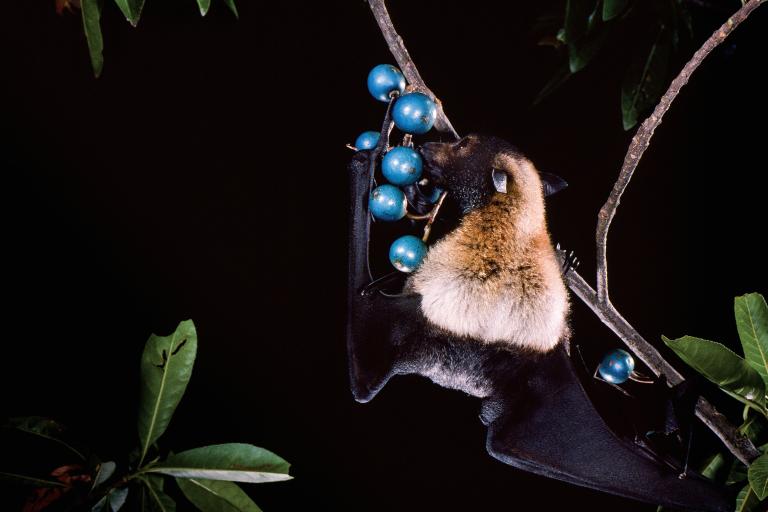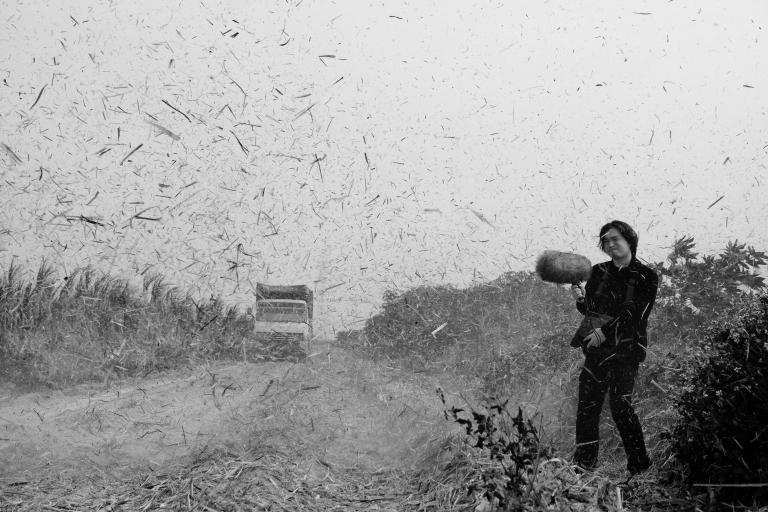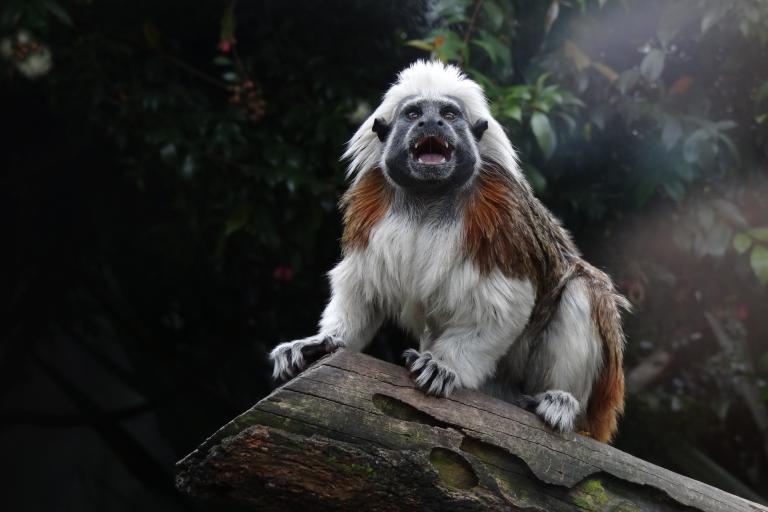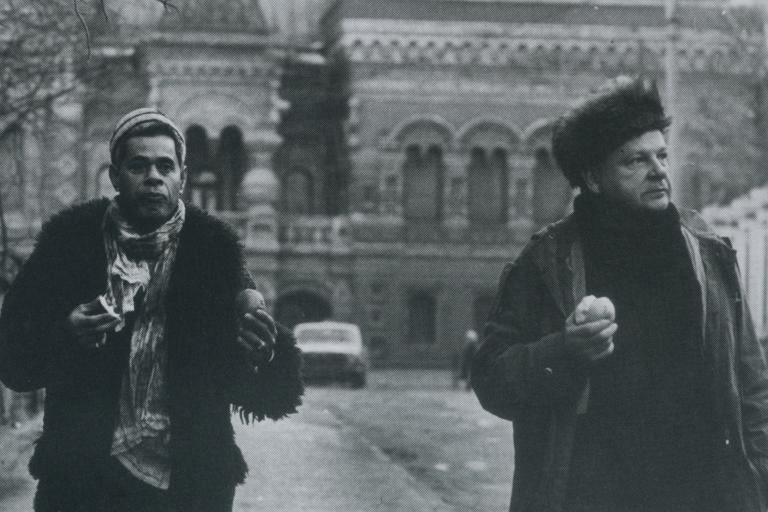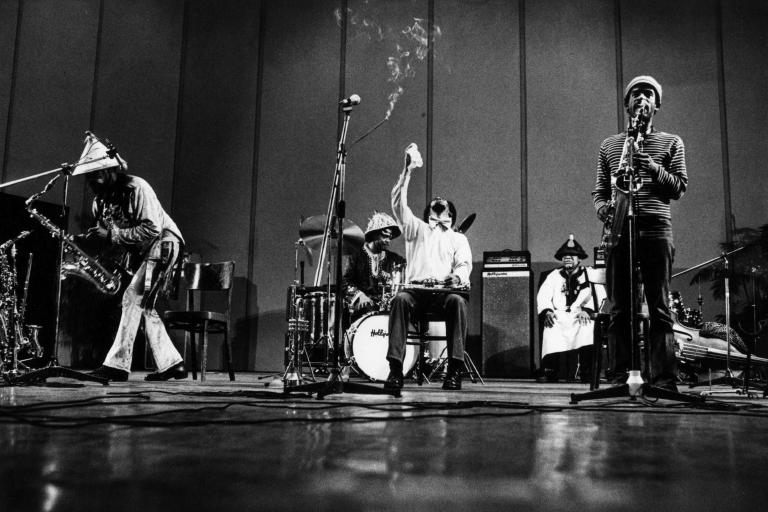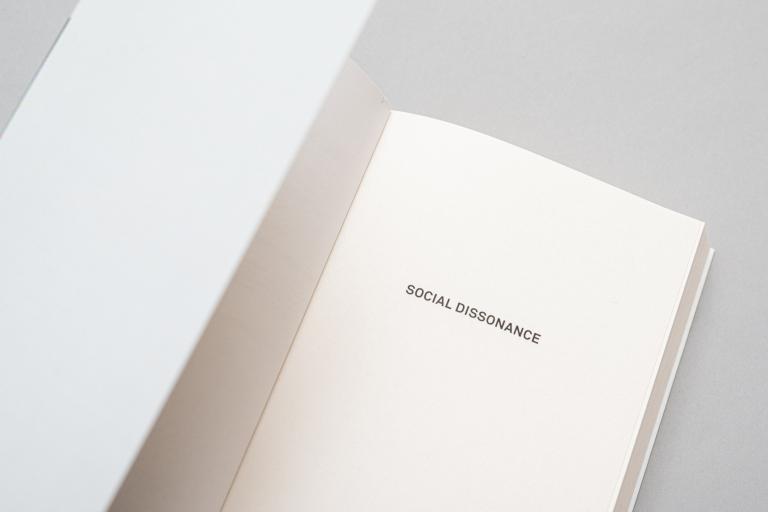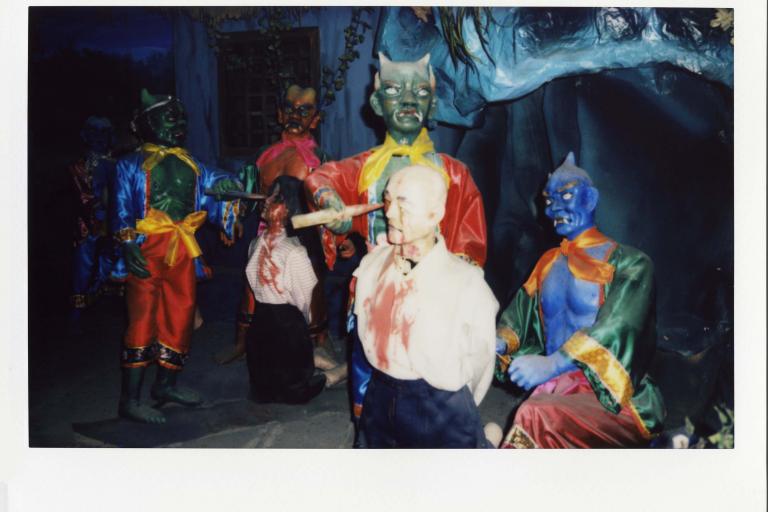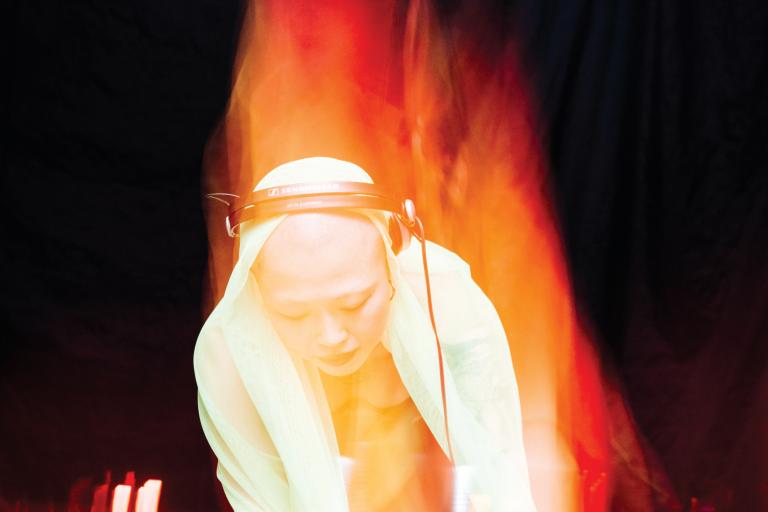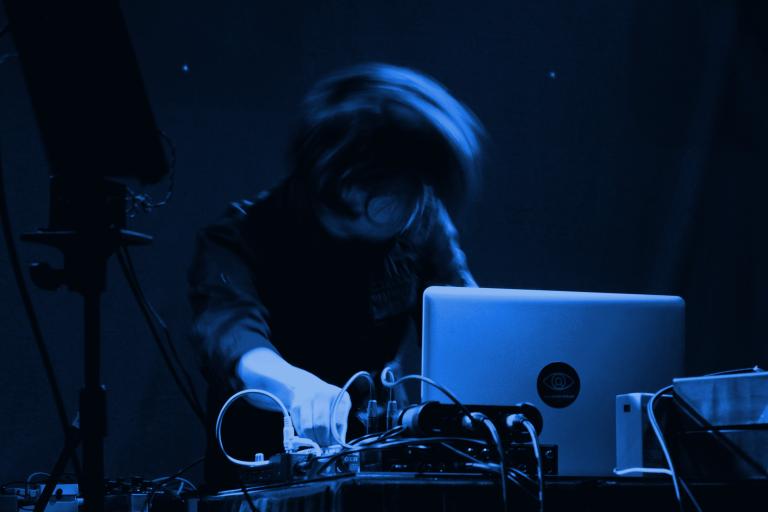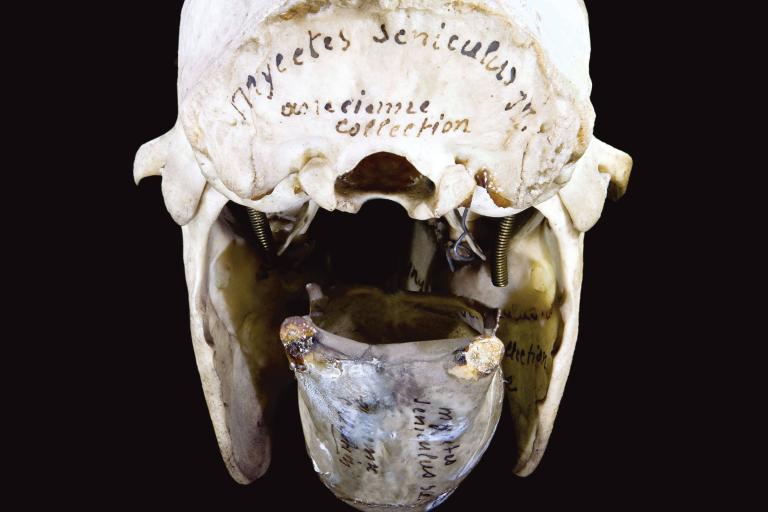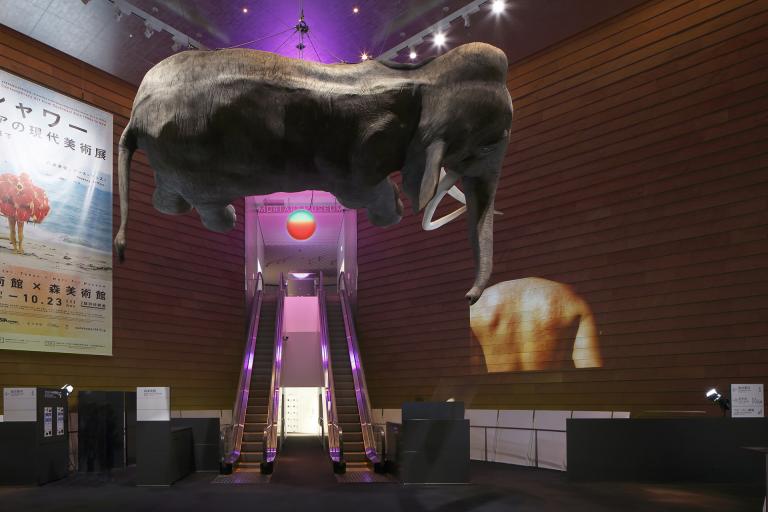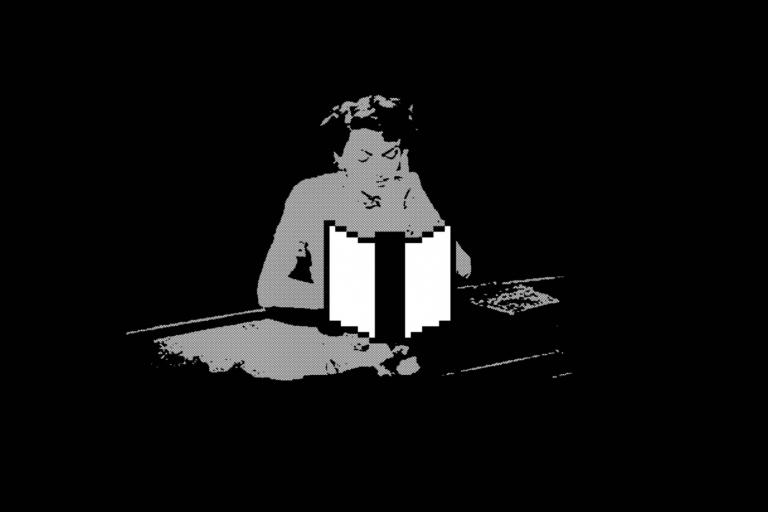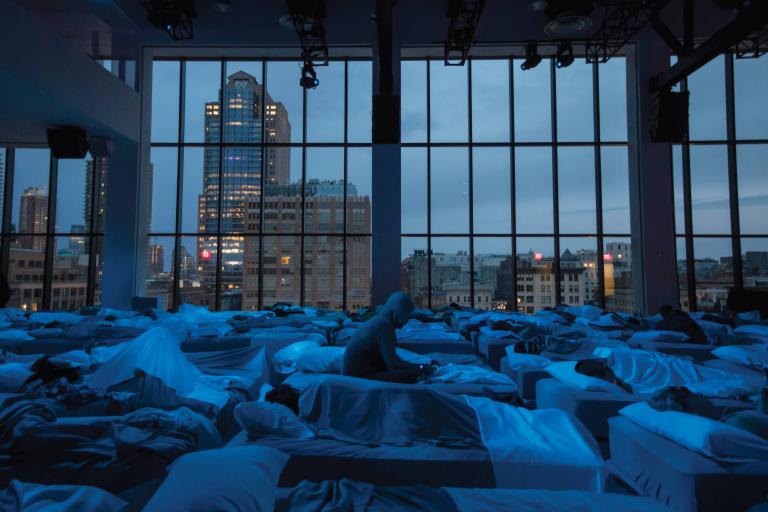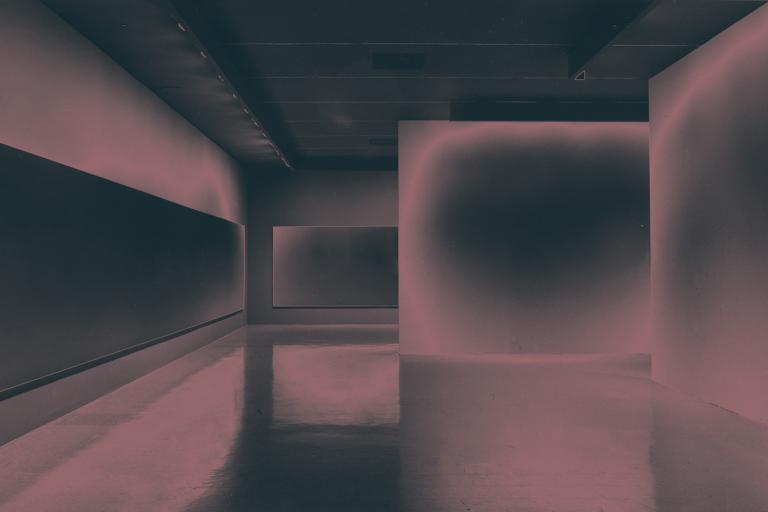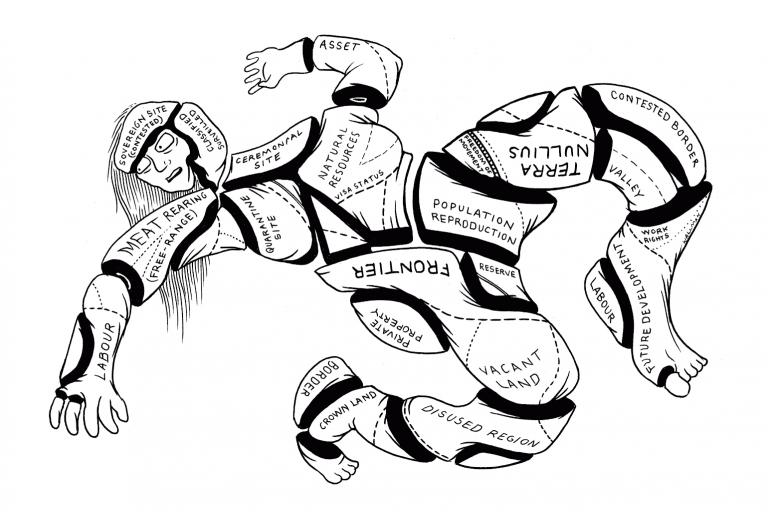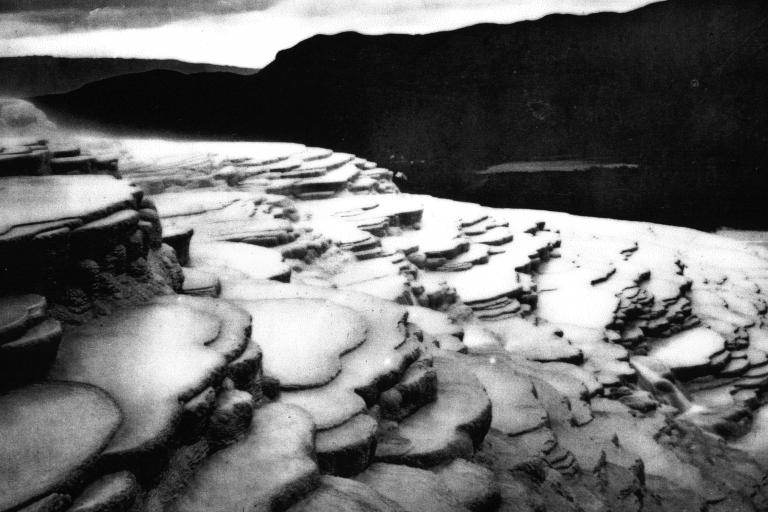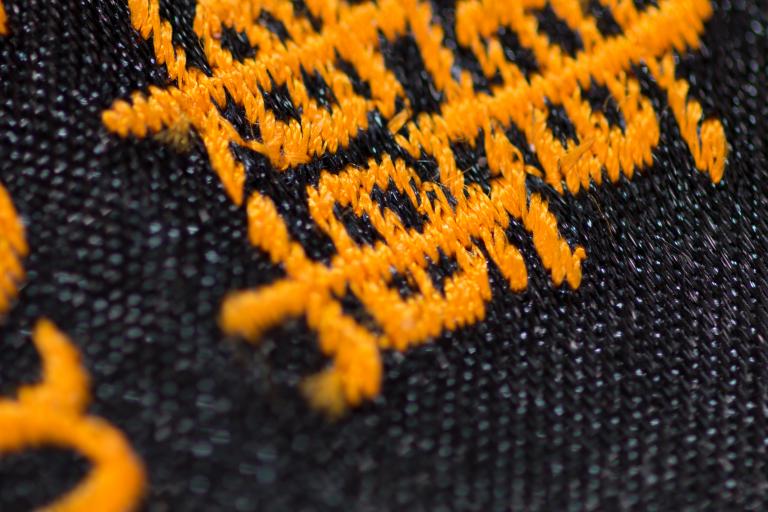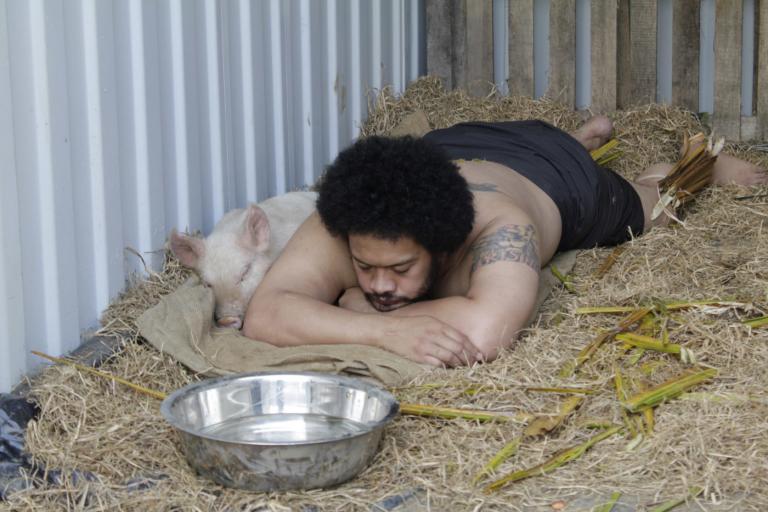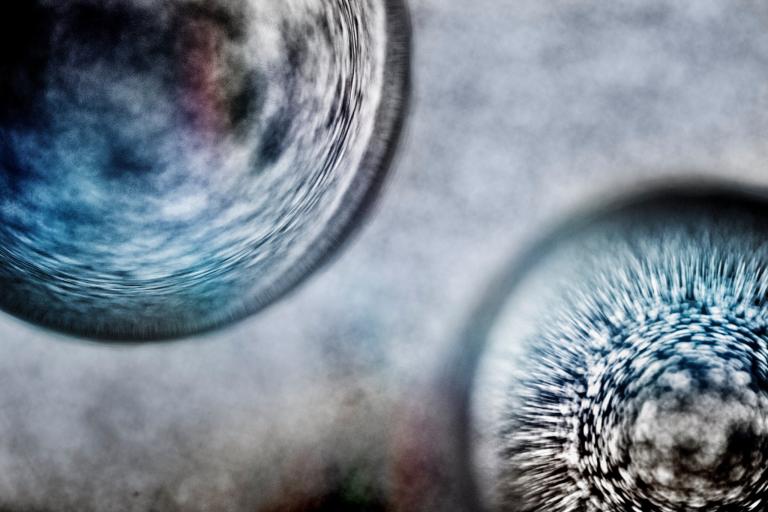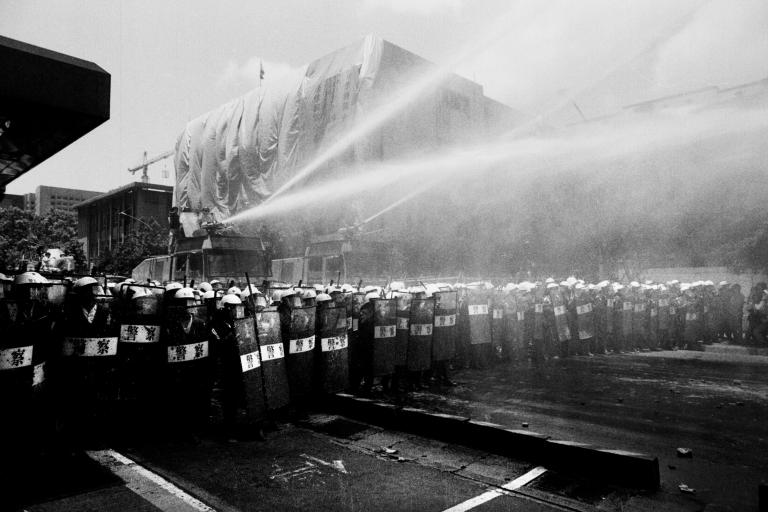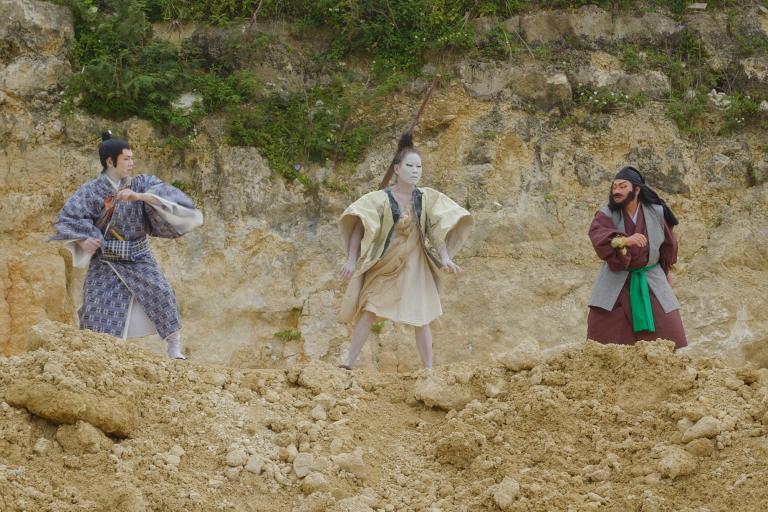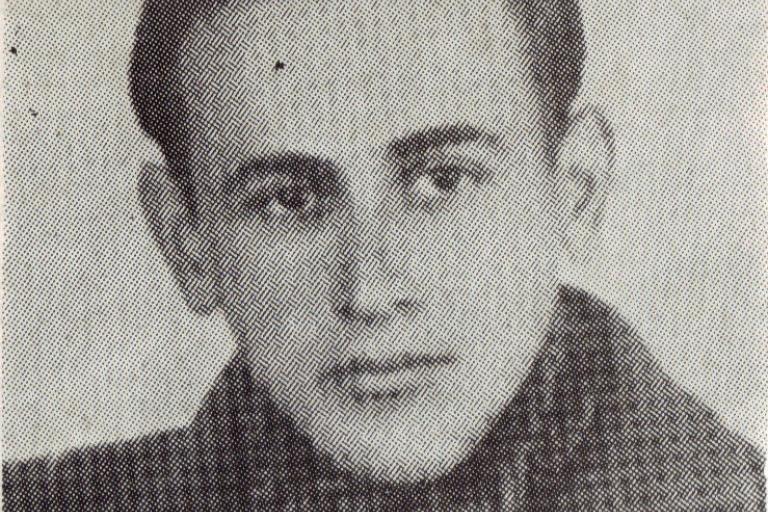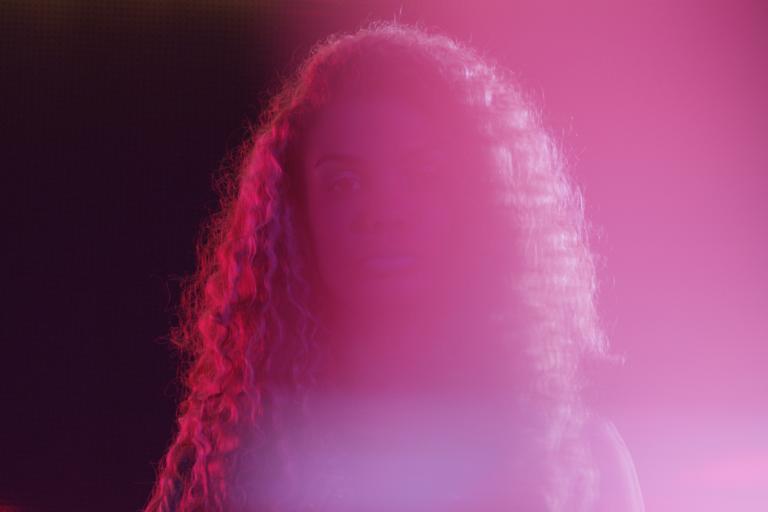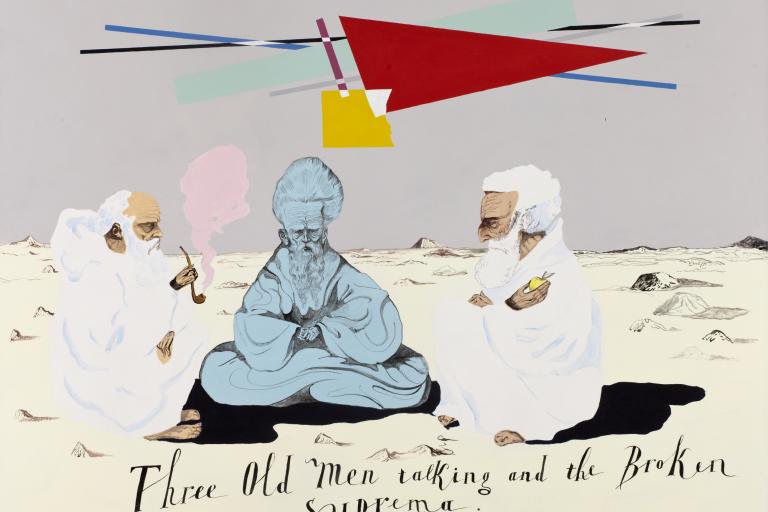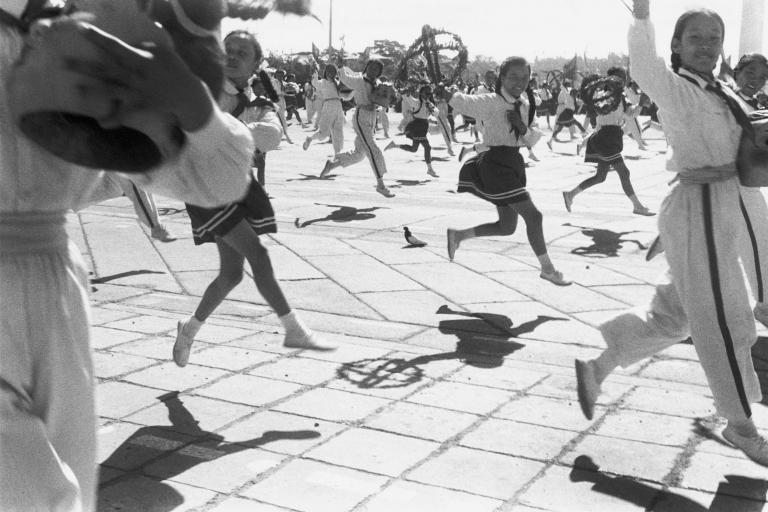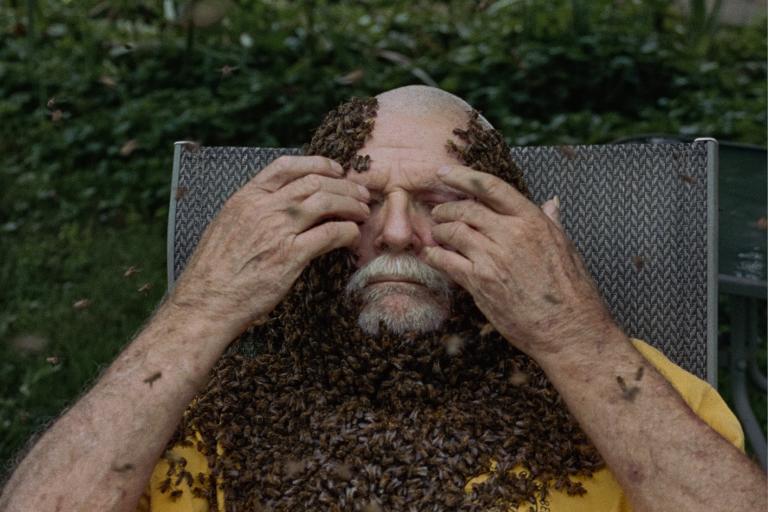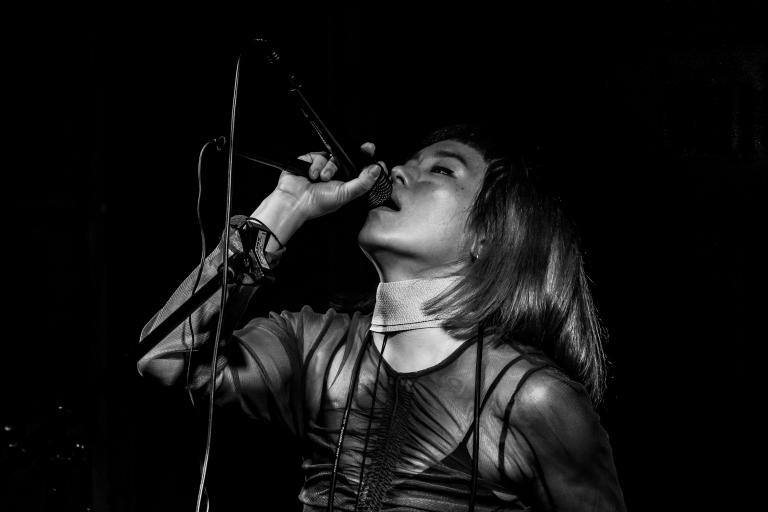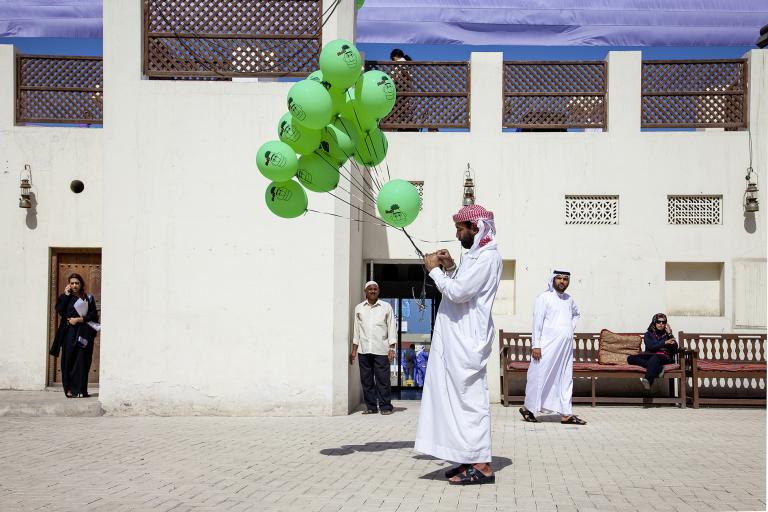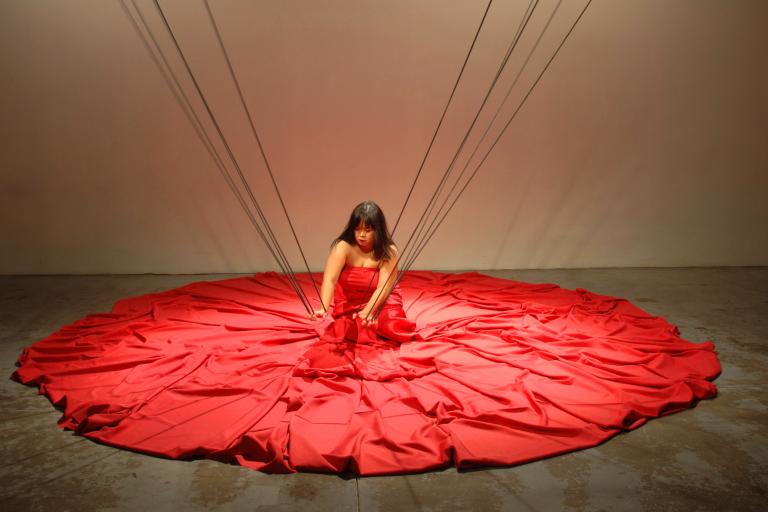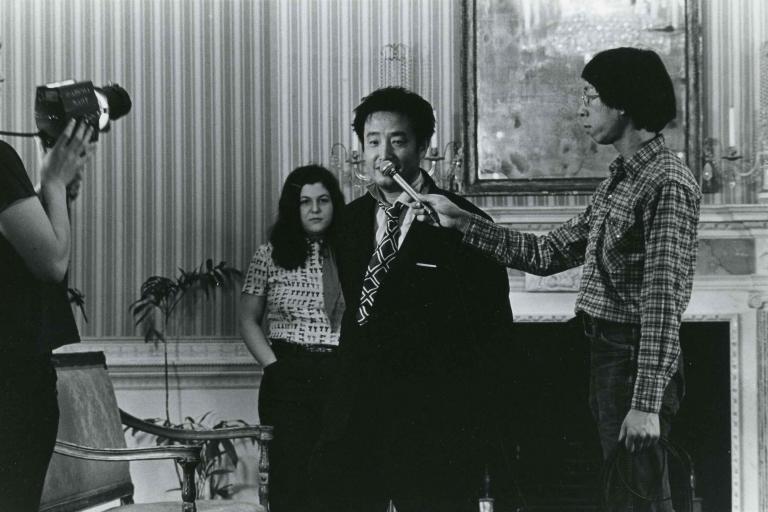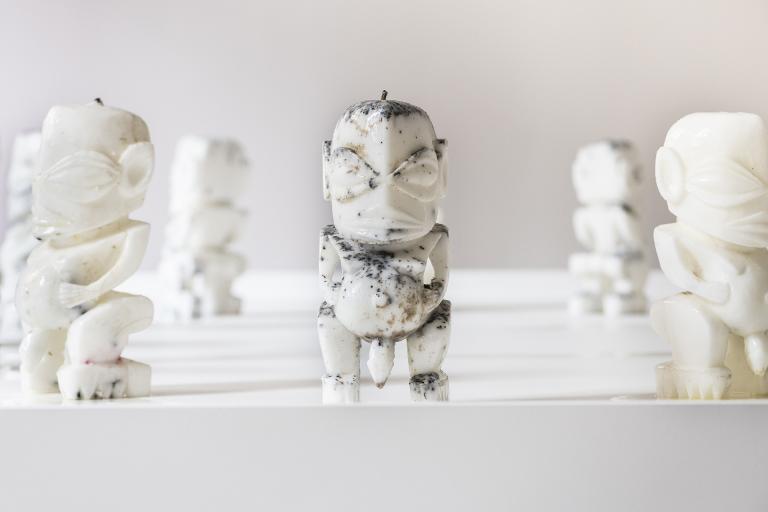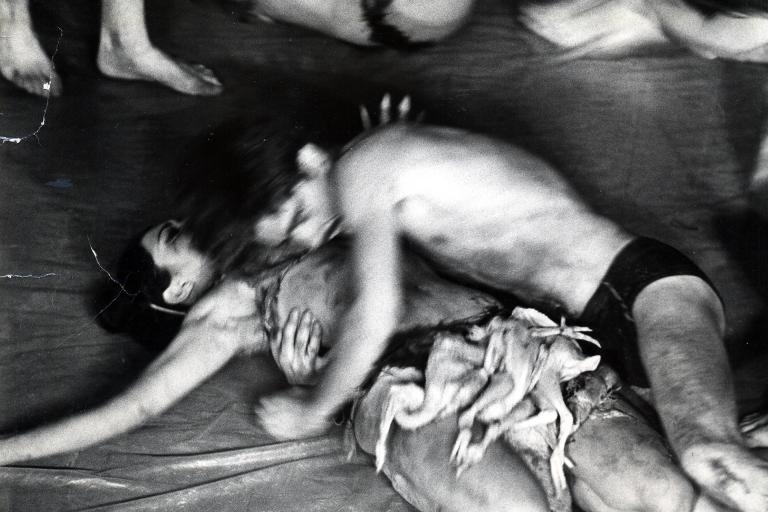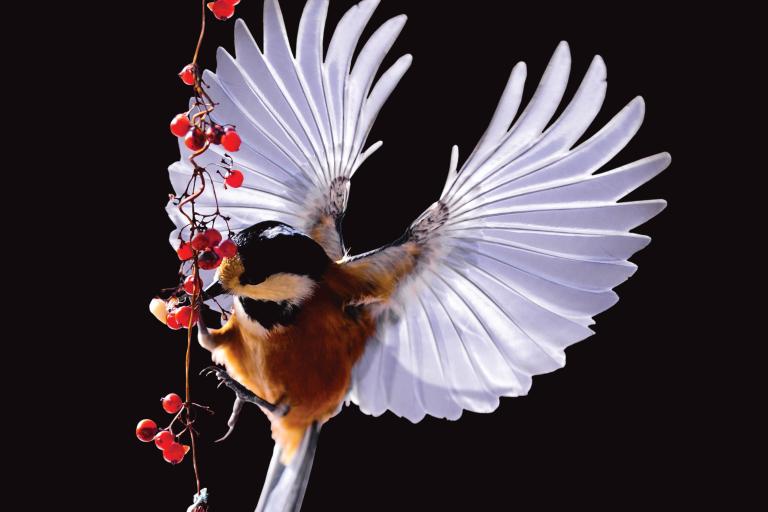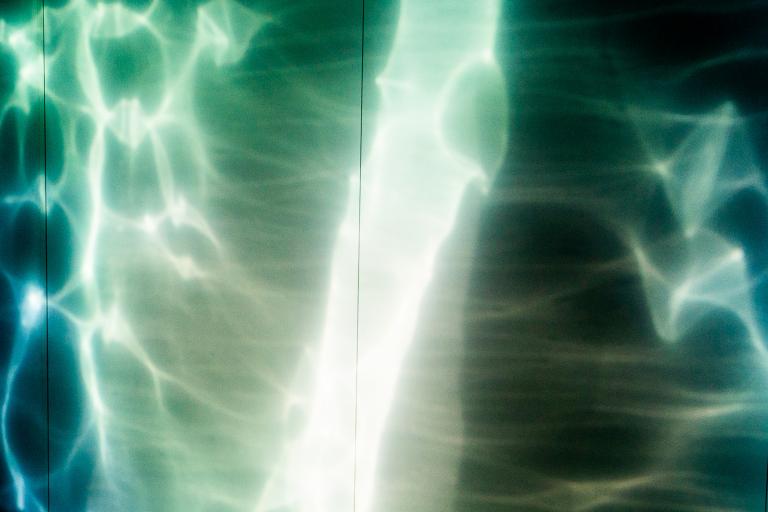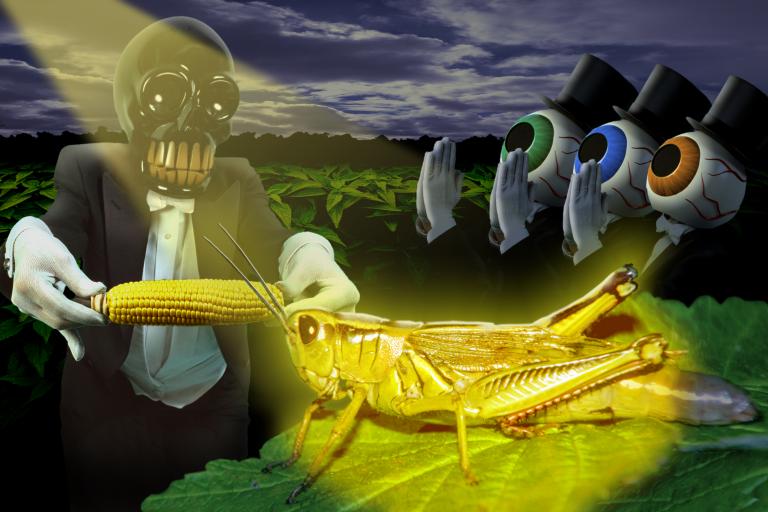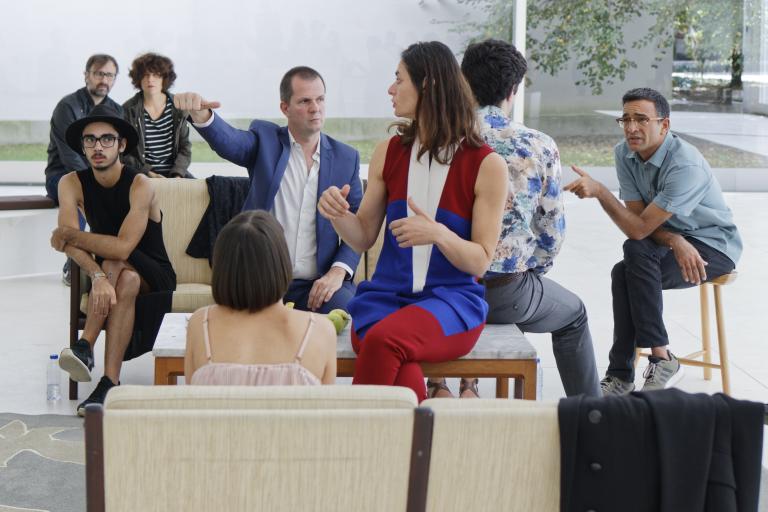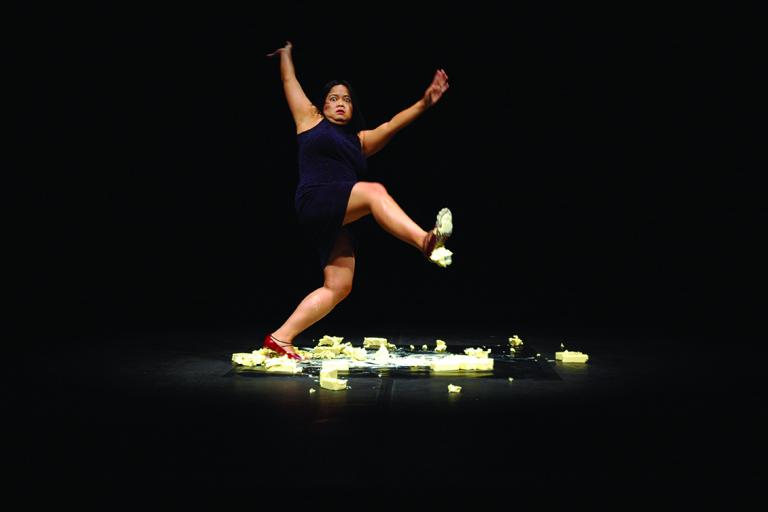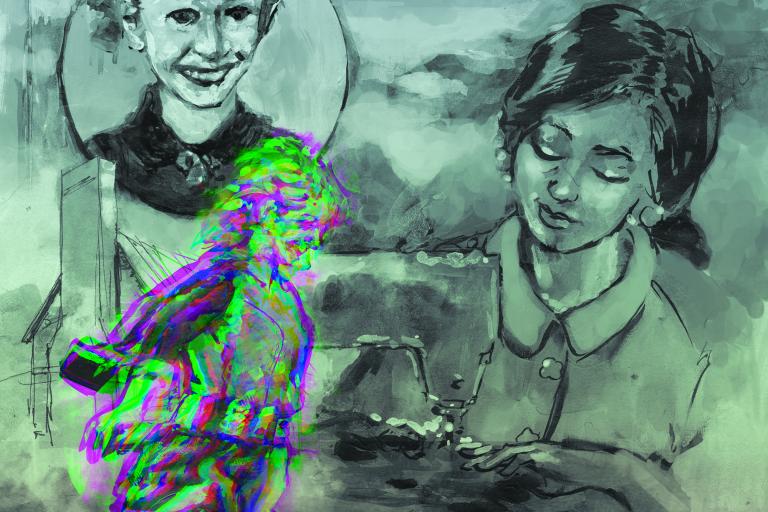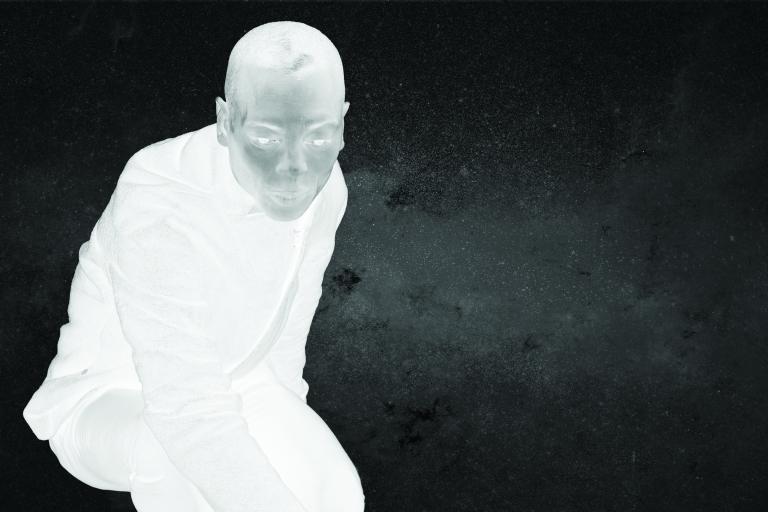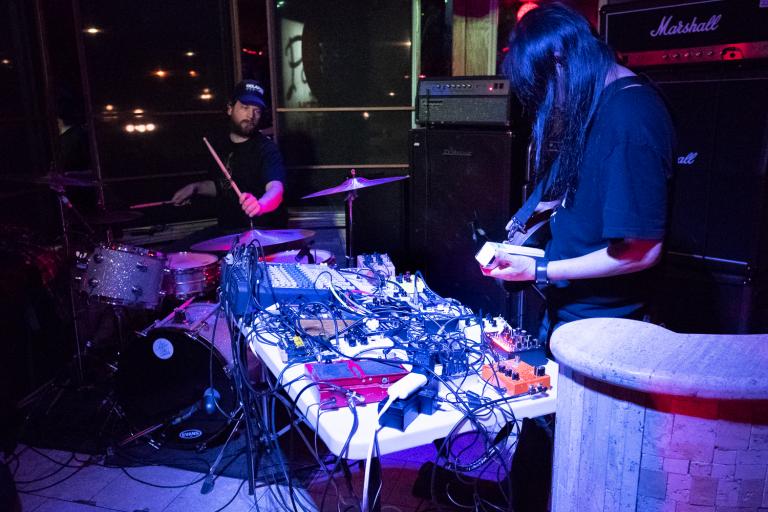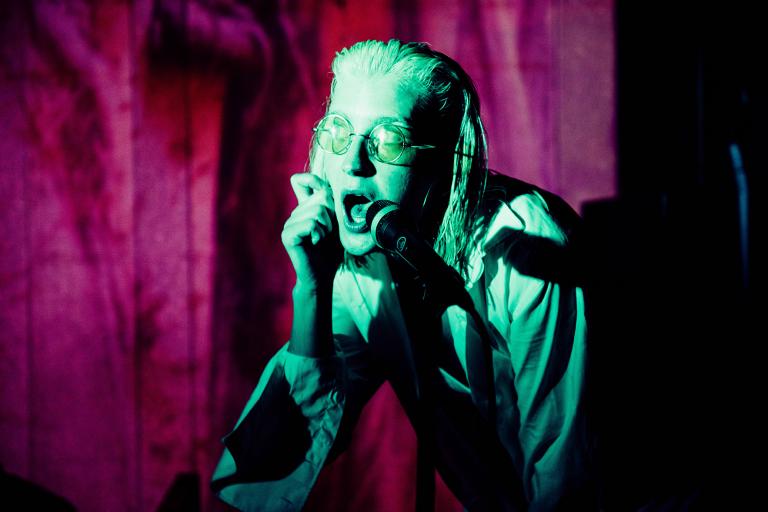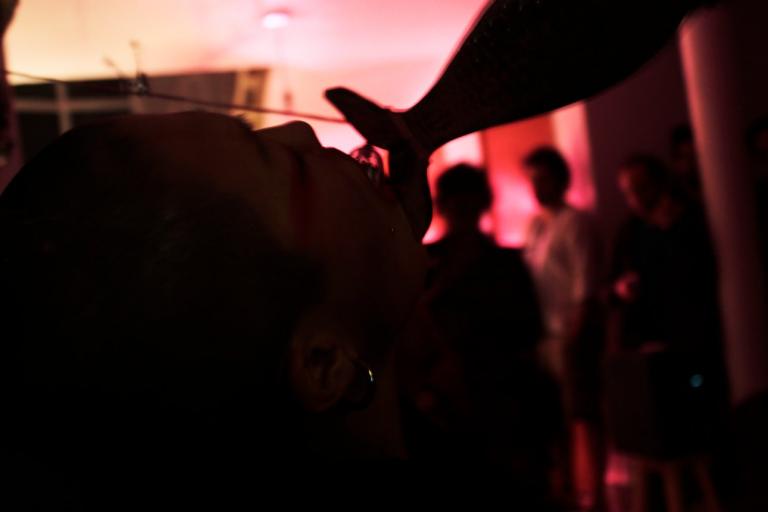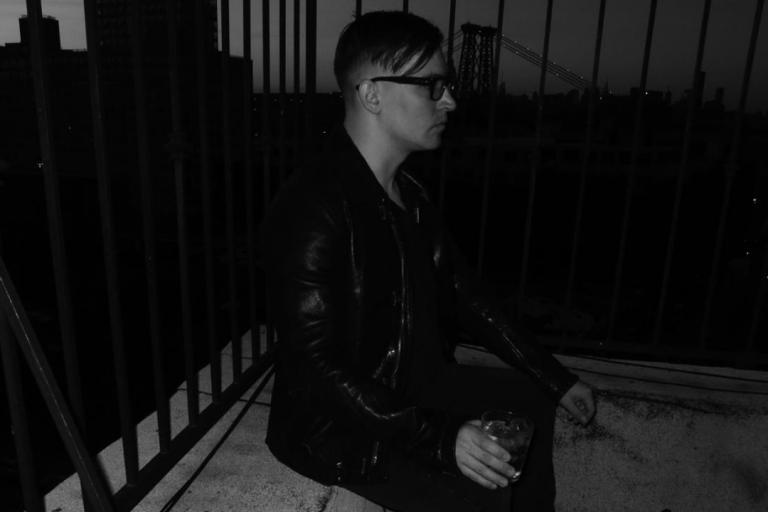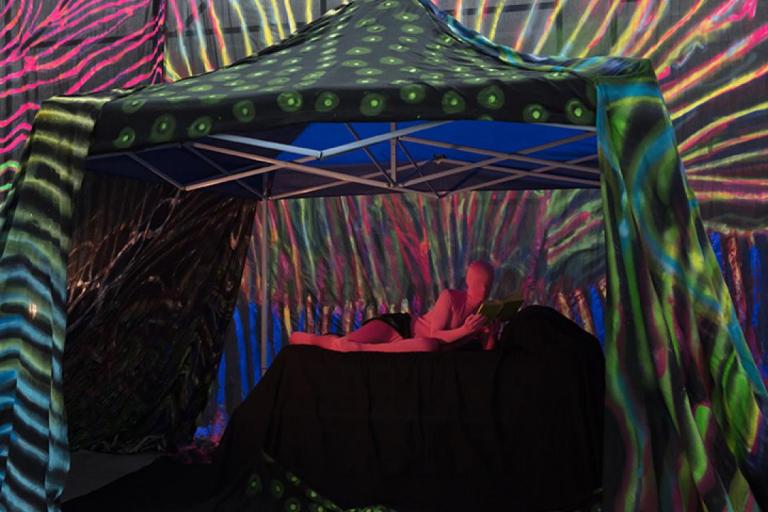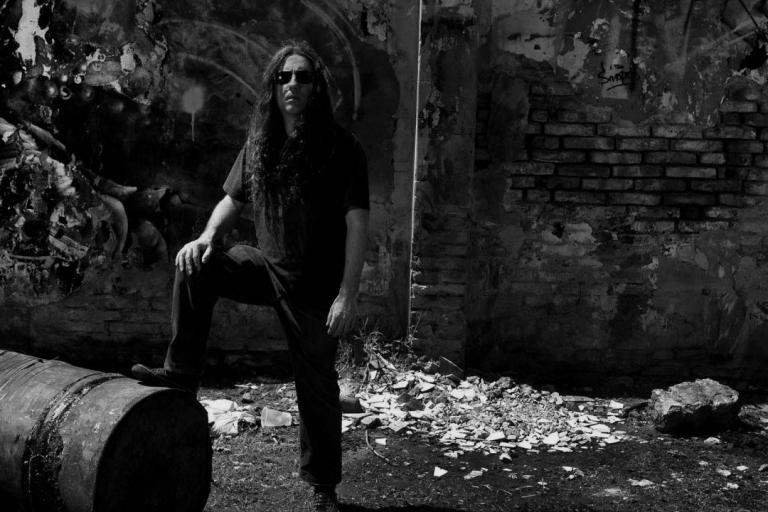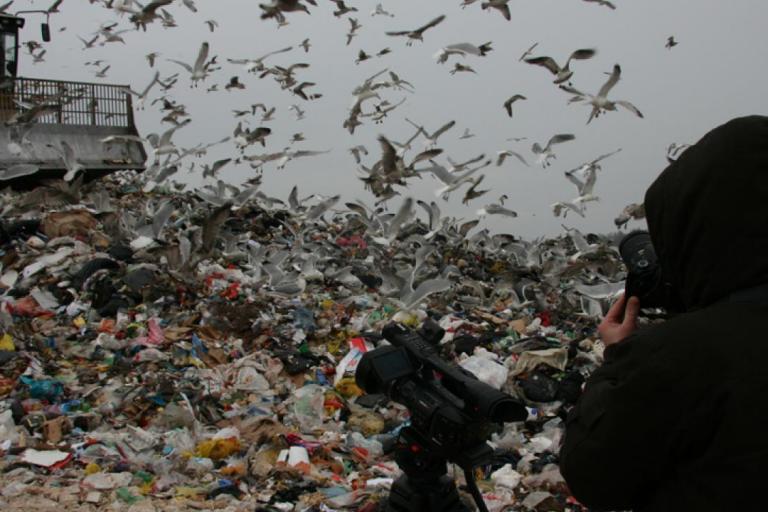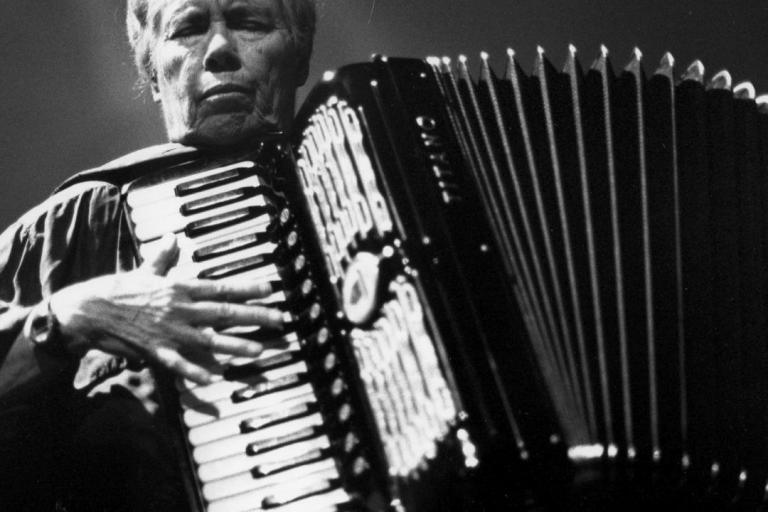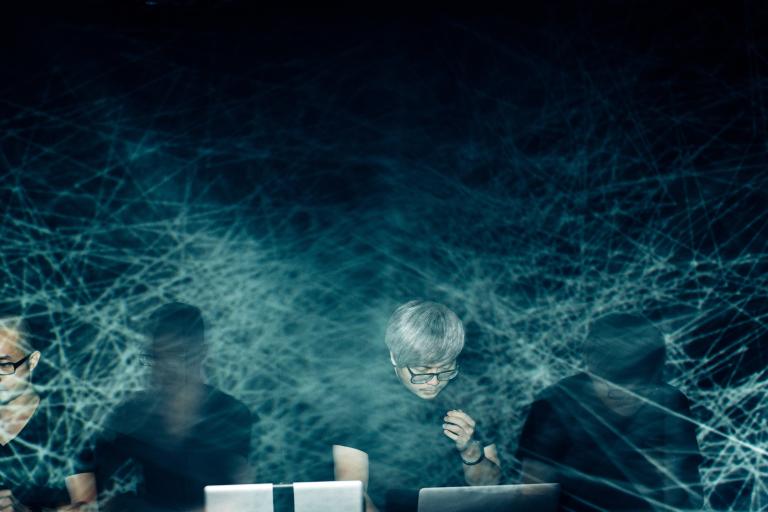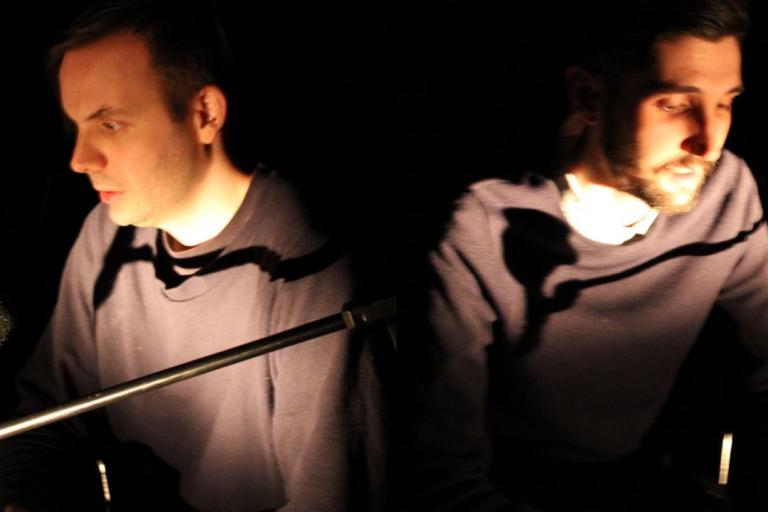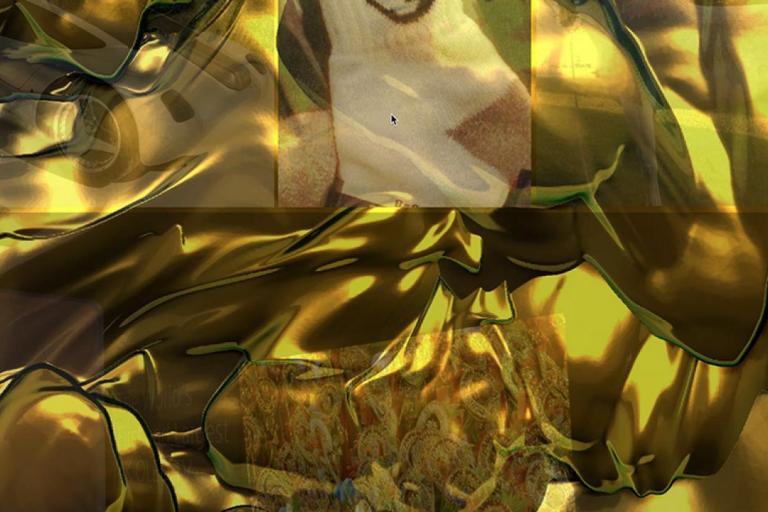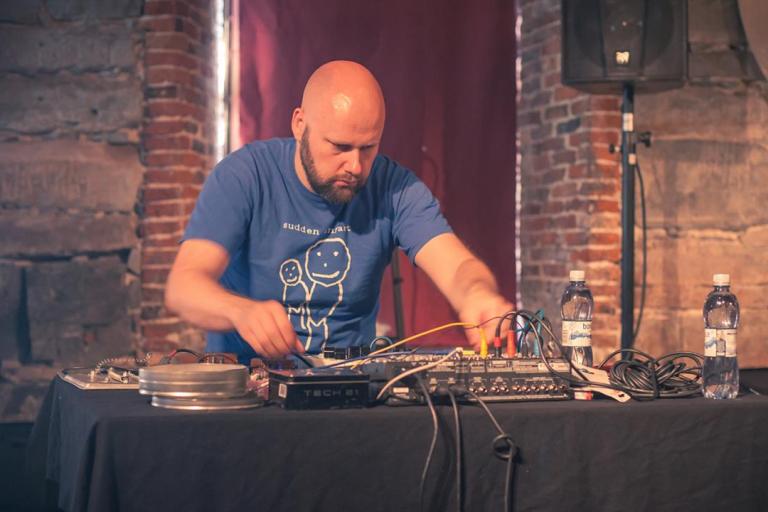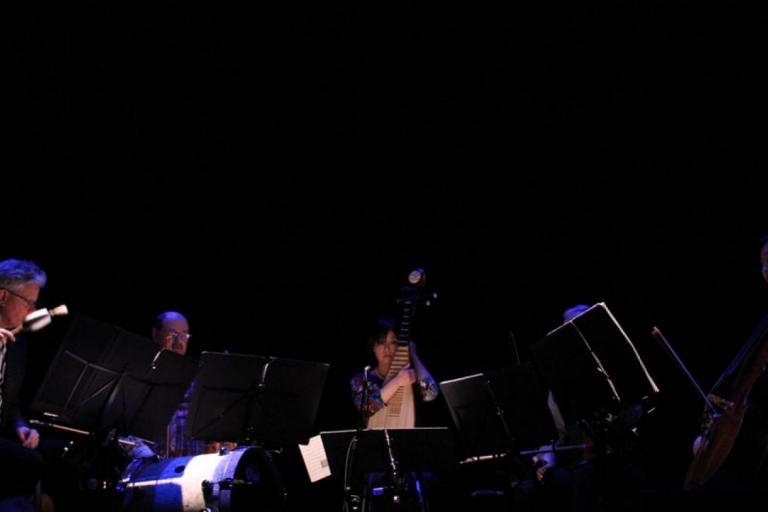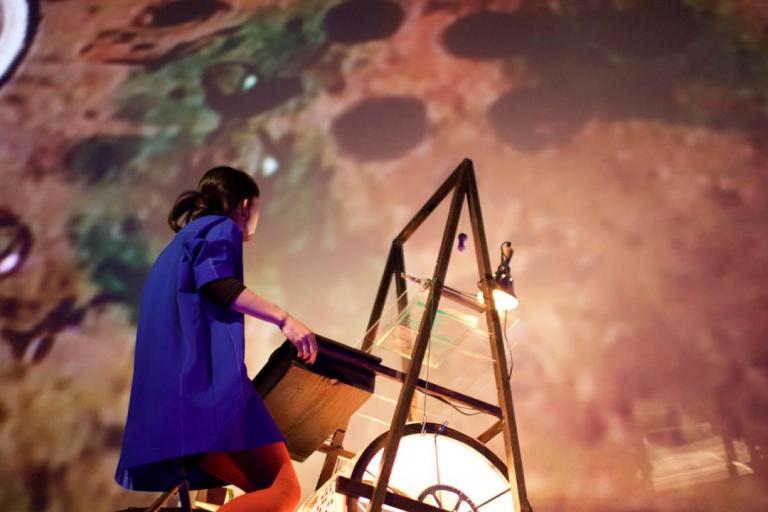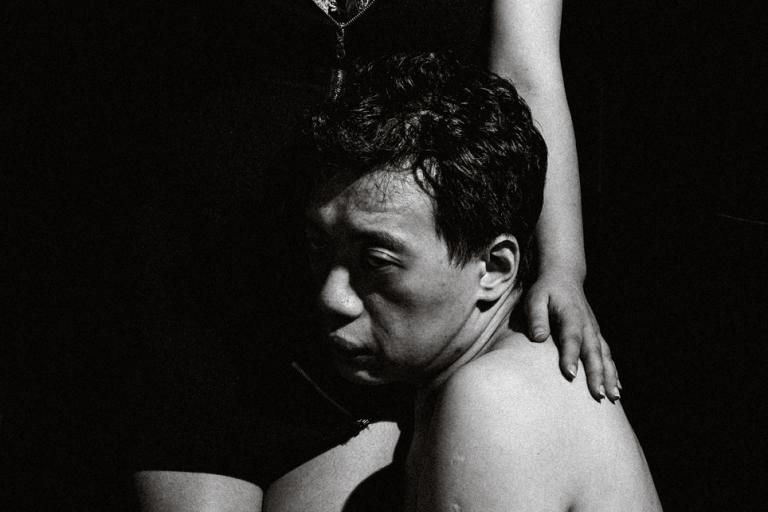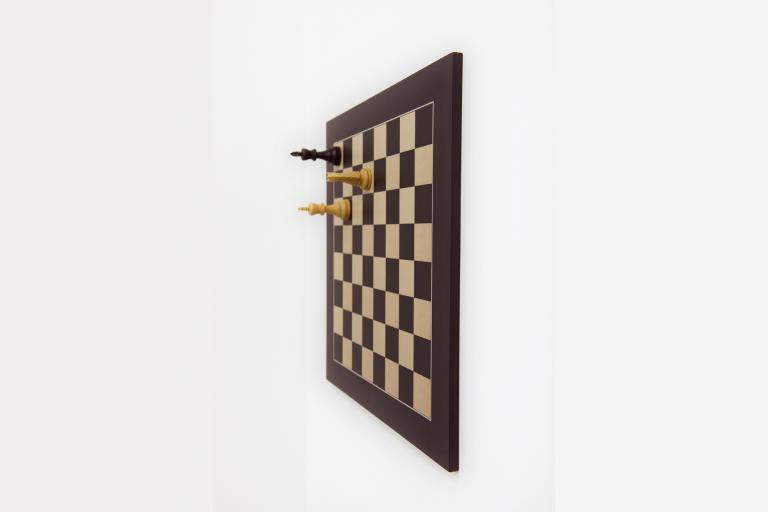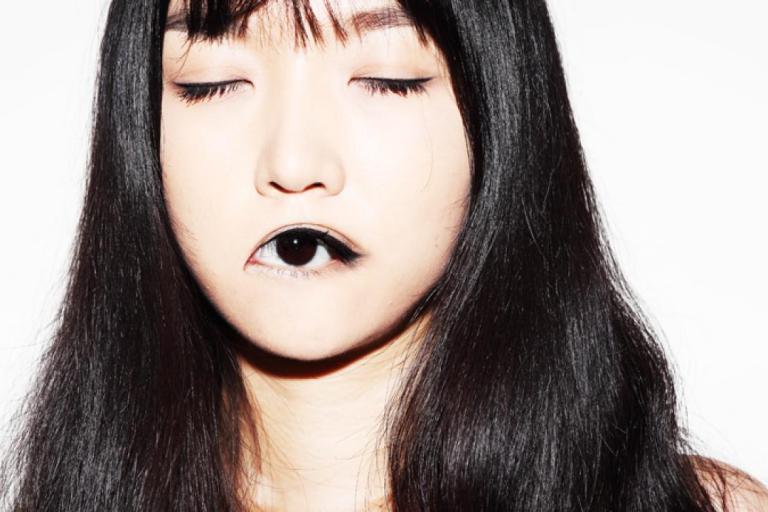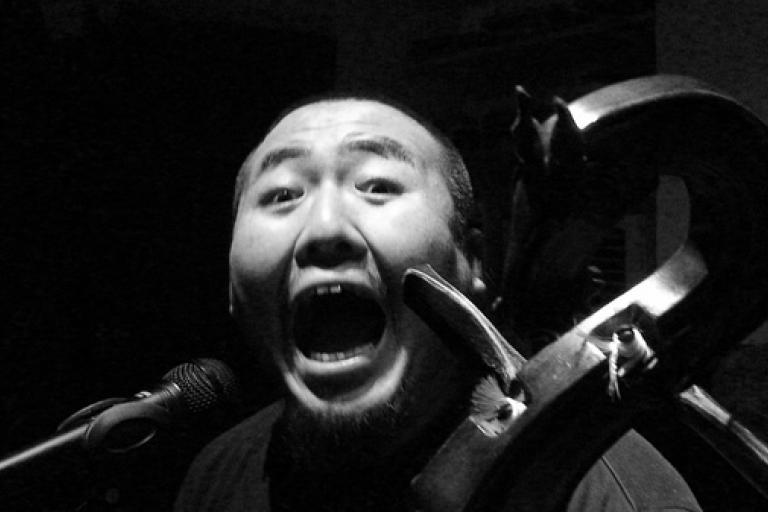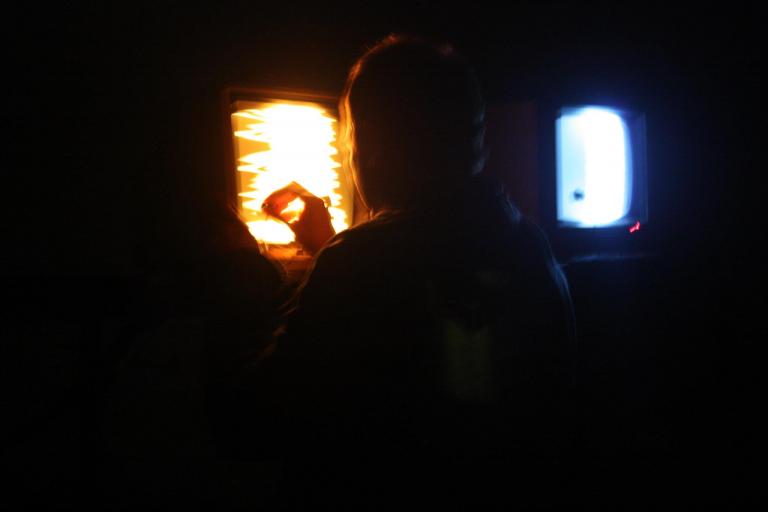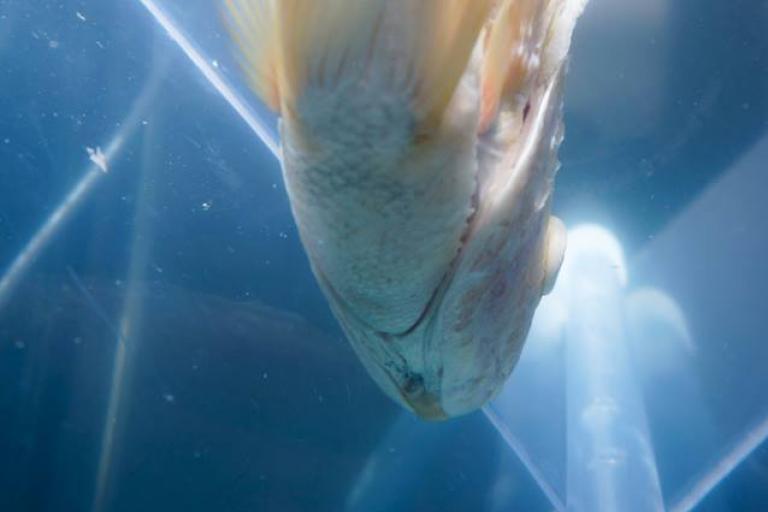It was at an electronic music festival on the east coast of Taiwan, Van Halderen says, that a startling creature came into their head. That being would become known as Taipei Popcorn. The year was 2017, and Van Halderen was visiting the island to reconnect with their Taiwanese then-boyfriend Henry.
Backpacking across Taiwan, Van Halderen ventured to Organik Festival in Hualien, where they would have a night of sudden transformation. “It was a deep mental state and physical experience,” they say. “I had this person come into my head, this creature. It was Popcorn.”
On the beach, Van Halderen encountered a woman dancing. “Her name was Lisa, which is the same name as my twin sister. She was bald, and I was bald, so we were both running around like these two bald creatures. She had all these wigs, and we were playing with them. And at some point, I had a sticker put on my head that said ‘erotic popcorn’.”
That night, Van Halderen, who had an educational background in industrial design but no prior stage experience beyond high school theatre, determined that they would enter the world of drag queen performance. That ambition would become a reality later that year when Van Halderen moved to Taiwan and Taipei Popcorn was born.
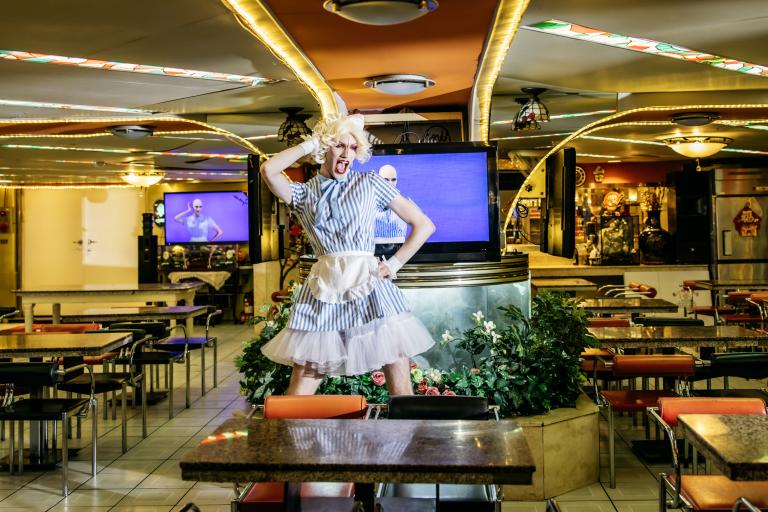
The name is multi-layered in meaning. It refers to the exploding of gender norms and binary definitions but also references the personal transformation Popcorn would experience upon arriving in Taiwan. Latent energy was set to explode into infinite and unpredictable baroque forms.
Taiwan was at that time undergoing a dramatic wave of cultural change. In 2019, it would become the first country in Asia to legalize same-sex marriage. There has been an accompanying boom of artistic and creative expression around fluid gender and non-binary sexual identity, a queering of Taiwanese artistic and popular culture.
“That huge queer change that was happening and the political movement was one of the big reasons for Henry and I to move to Taiwan and set up a life there,” Popcorn says. “We both felt there was something big and historic going on, and we wanted to live amongst and be part of it. I think this is a huge draw for a lot of the LGBT foreign and overseas Taiwanese community. Taiwan is a kind of magnet for us.”
For Popcorn, it was a dramatic shift. “I had been in Japan for three years, and I kind of went back in the closet,” they say, “because I was teaching in this very conservative small town and school. Japan has no anti-discrimination laws, so you can be fired for being gay or trans.”
“All this energy had built up, and that’s where Popcorn came from. It was kind of like a kernel that had built up bursting — POP! — a moment where all this queer energy came streaming out of me. I was just beaming rainbows at that festival, and I realized I need to stop hiding myself.”
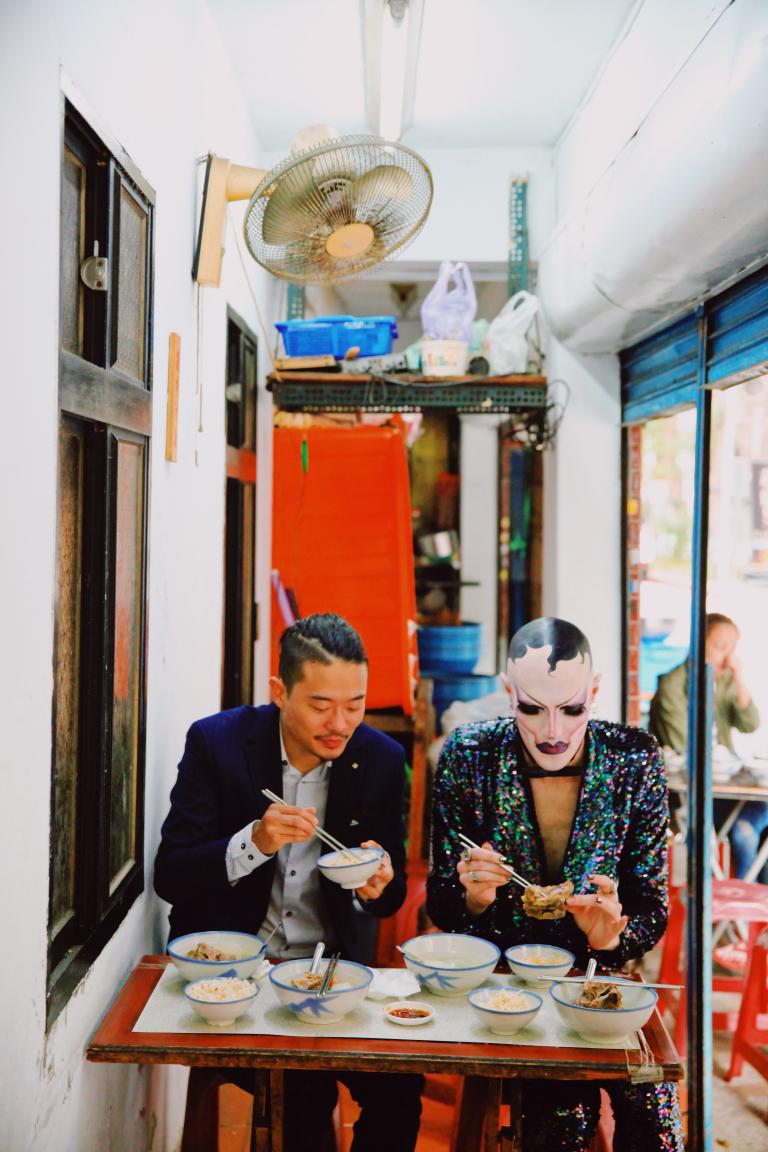
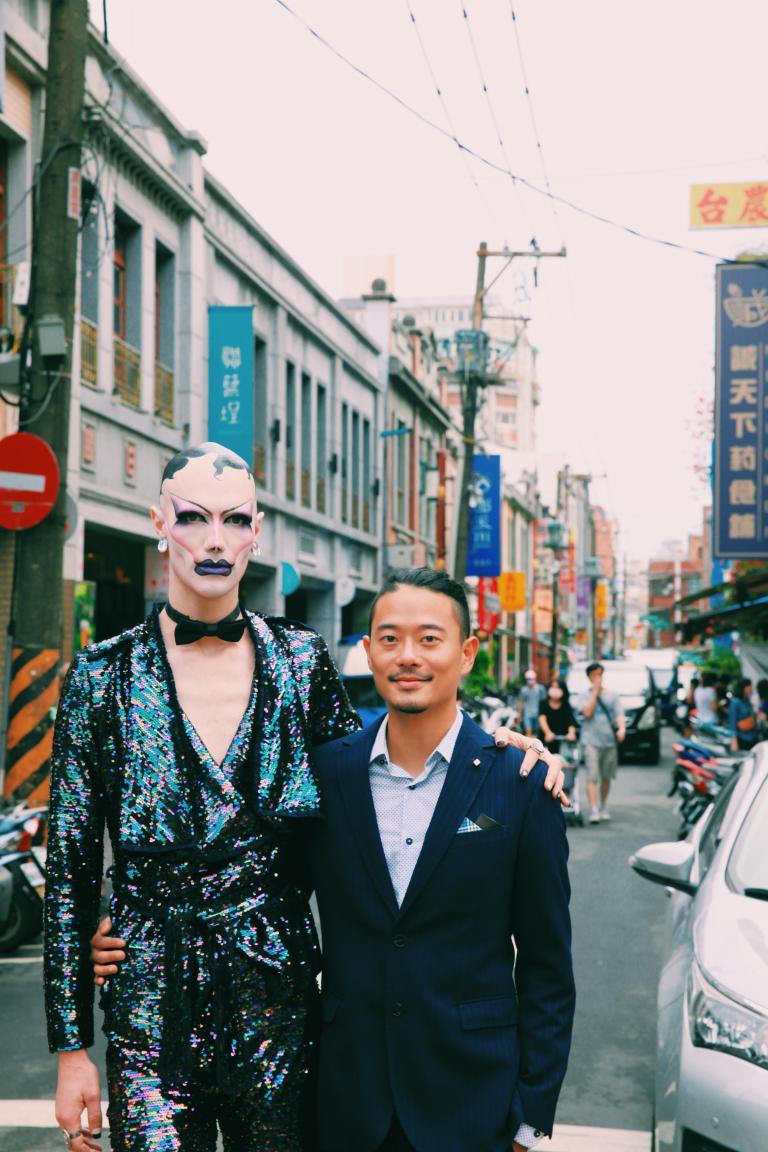
Popcorn moved to Taipei to be with Henry, who had returned to the city after also living in Japan. Two years later, they would travel back to New Zealand together and marry. The marriage is now recognized in Taiwan. Theirs is an unusual love story. Both had spent time growing up in New Zealand. Henry, as a 12-year-old, moved from Taiwan to Christchurch. Popcorn, at age 11, left South Africa for Dunedin, and is now a New Zealand citizen. But the two never crossed paths in Aotearoa. Instead, they would meet at an underground gay club in Osaka.
“It was a bar called FrenZ FrenZy,” they say, “a very smokey and psychedelic hole-in-the-wall whose main claim to fame was being visited by Lady Gaga years before. It wasn’t love at first sight, haha, but we had some good conversation and then a weird date in which we were both very guarded. We didn’t see each other again for months until we ran into each other at Osaka Pride. Then everything clicked.”
Not long after moving to Taiwan, Popcorn made their first public appearance in drag at Taipei’s Pride Parade, the largest event of its kind in Asia. “I gathered together this blue look,” they say, “and did the Pride Parade in high heels.” The next day, Popcorn picked up a copy of the Taipei Times, and there was a photo of them on the front page.
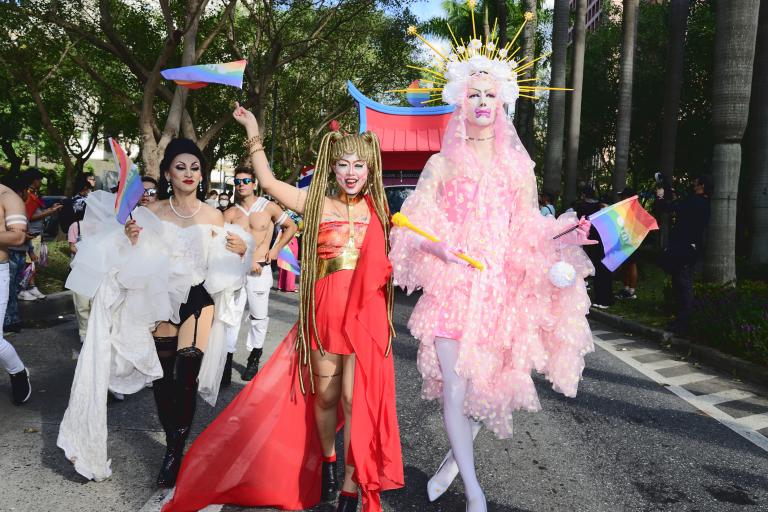
Things flowed from there. Taipei performance artist Betty Apple contacted Popcorn and invited them to perform at an event she was curating at the National Museum of Fine Arts in Taichung. Apple was collaborating with the Tokyo art collective Chim↑Pom in their work Street at the Sixth Asian Biennial, which the museum was hosting.
As part of the project, Chim↑Pom asked Apple to create a Block Party outside and inside the museum channeling Taiwan's rebellious, creative spirit. Apple invited Popcorn to perform. “It was very trusting,” Popcorn says, “because she’d never seen me perform. She messaged me on Instagram. I was in Wellington at the time, just visiting. She messaged me and said, ‘Are you a drag queen?’ And I said, ‘I can be.’”
Apple had an intuition that it would work. I spoke to her about Popcorn, with whom she has continued collaborating. “Popcorn has their own unique aesthetic style,” she says, “full of queer elements with a non-binary, science-fiction feel. They collage ready-made objects onto their body to create abstract textures. Popcorn makes good use of their height to transform themself into a conspicuous and gorgeous alien queen. People can’t avert their gaze. It’s like hearing the sound of popcorn!”
On the night of the Block Party, Popcorn and others returned to Taipei. “We all came back to Taipei on a KTV [Karaoke] bus,” they say. “And we went to a gay party called C.U.M, which is a big thing here. I was in full rainbow drag. I met Bouncy Babs, one of the stalwarts of the Taipei drag scene, and she booked me to perform at the club for the next month. I started performing at that party, and it just grew from there.
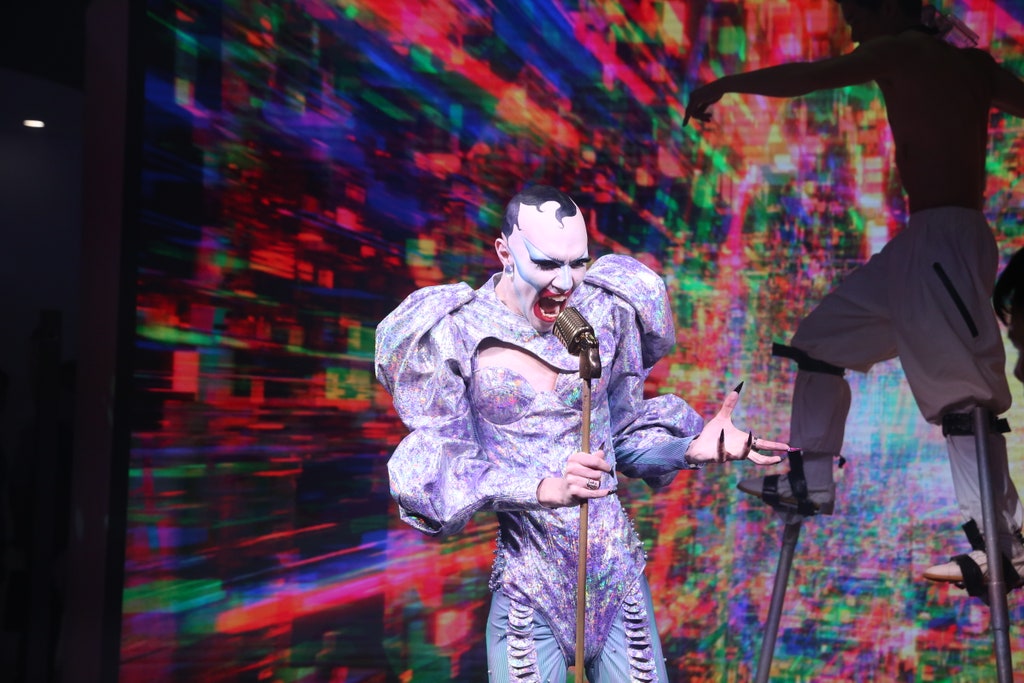
“At some point, we started doing our own party called Blush at a club called B1. It was a monthly party I held with Bouncy and Amily Givenchy, another drag queen here. We wanted to go with more of a techno, underground feel. Every month we had to produce this quite detailed drag show and promote it. People started contacting me about parties, festivals, and events. I started working with techno label Smoke Machine, and they sent me on a tour of Chengdu, Beijing, Hong Kong, and Hanoi.”
In 2020, much of the world was in lockdown, but Taiwan had remarkably made it through the first year of the Covid-19 pandemic mostly virus-free, without shutting down. It was the year following the legalization of same-sex marriage, and queer events were thriving, unencumbered by fear of the virus. To many, Taiwan appeared to be a queer utopia. Looking back at social media posts from the time, even its participants seem to be pinching themselves that it was really happening.
In October of that year, Popcorn starred in an elaborate large-scale theatrical performance on the opening night of Taipei Fashion Week. Organized by Vogue magazine, Fashion’s Night Out was an interactive and immersive theater event merging fashion and art according to a theme of dystopian end times. The event featured performance artists, dancers, a circus crew, and models wearing clothes by local designers.
Popcorn appeared as a prophet/queen who is first stalked and harassed by the other characters. Fearful initially of this splendidly unnerving creature, the others come to worship the queen. The performance ends in a wild ritual with Popcorn, wearing “futuristic drag Pisces couture” created by Taipei designer B Drag, commanding center stage behind a vintage standup microphone and surrounded by a frenzied harum of dancers.
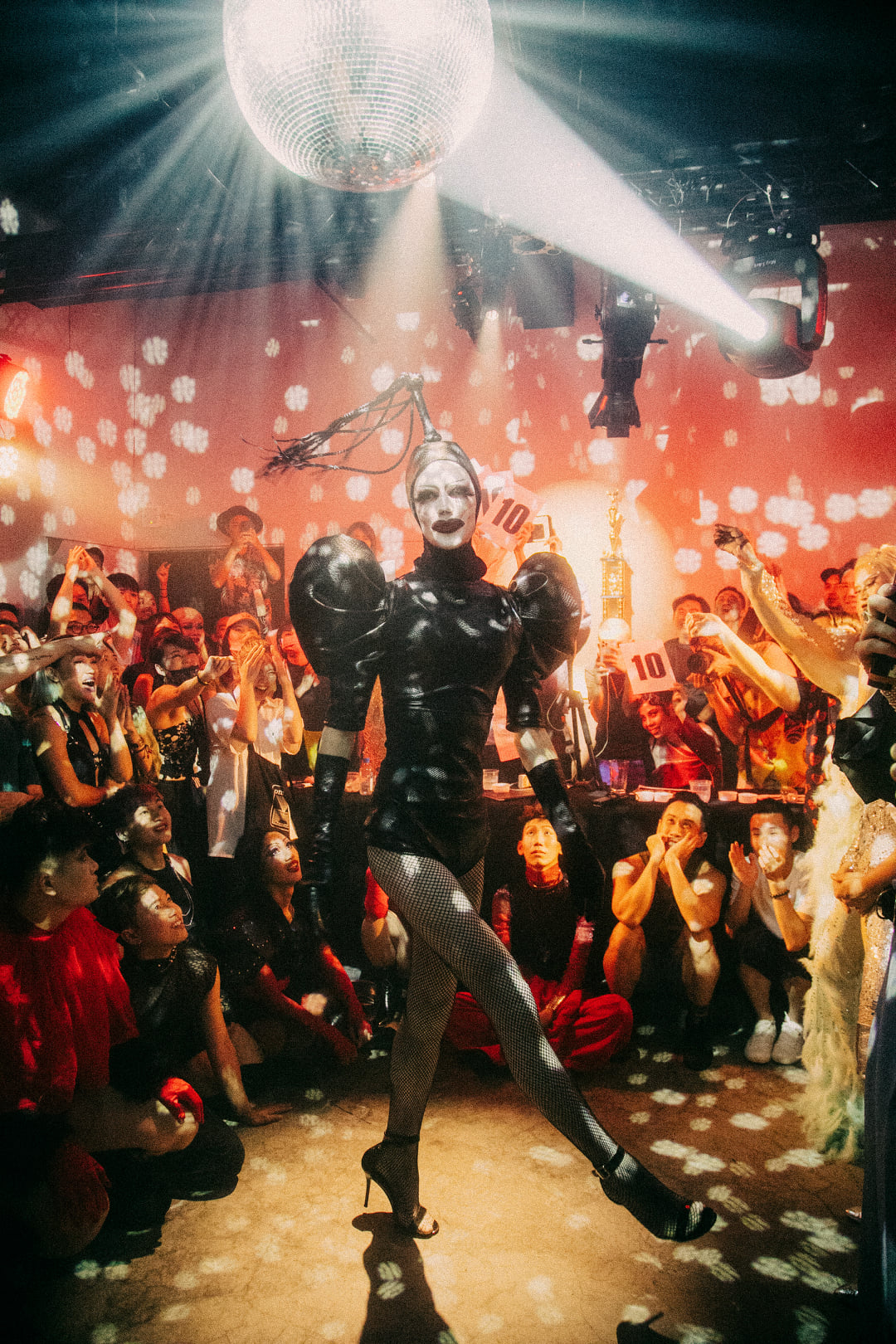
Later this year, Popcorn will make their full-length movie debut. Popcorn is co-starring in Future Shock, a film by director Su Hui-Yu, alongside award-winning actress Wu Ke-Xi. The three held a press conference in late 2021 to announce the project, which was covered widely by the Taiwanese mass media.
The film features Wu as the last human on earth who discovers that his (Wu plays a male role in the film) grim present is actually a dystopian future that had been accurately predicted by futurist Alvin Toffler in his 1970 book of the same name, Future Shock. Receiving a message from the past, Wu’s character sets out to find the book. Along the way, there are a number of psychedelic scenes. Popcorn’s role, Su tells me, is that of an omnipresent metaphysical being. “Sometimes they look like God; sometimes they appear evil in the human's dream; sometimes they’re a computer from the future.”
Popcorn has worked previously with Su on numerous occasions. The director, who creates work often dealing with queer culture and body politics, has cast Popcorn in his short films, which have been screened at film festivals and exhibited as installations in art museums all over the world. Popcorn in these projects doesn’t strictly appear in drag. “I think he likes to work with me,” Popcorn says, “because I can transform into all these different creatures.” Indeed, Su tells me he admires Popcorn’s “plasticity”.
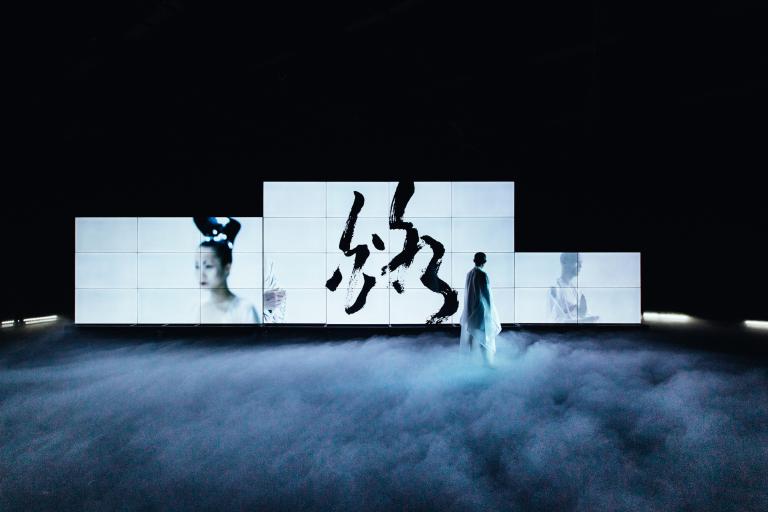
While Van Halderen may seem a million miles from home, the artist’s creativity is rooted in their experiences growing up in New Zealand. As an eleven-year-old, Van Halderen moved to Dunedin from South Africa and is now a New Zealand citizen. Their parents wanted them and their sisters to grow up in a safer environment.
But the move was initially hard. Not only had Van Halderen left everything behind, but being gay at an all-boys high school also made for a lonely experience. Van Halderen suffered from bullying, which resulted in deteriorating mental health. They began self-harming and had frequent suicidal thoughts. Fortunately, Van Halderen found solace and inspiration in studying karate.
“I started doing Goju-Ryu Karate when I was twelve,” Van Halderen says. “One of my friends was doing it and invited me to join him. I was having a bit of a difficult time at school and didn’t have many friends or much confidence, and I think my parents thought it would help.
“My teacher really had a huge impact on me. His name is John Marrable. He’s a bit of a legend in the world of Goju-Ryu Karate. John broke his back when he was a child and has used a wheelchair ever since. In the decades following the accident, he has been awarded multiple black belts and trained all over the world. He fights with his upper body and uses special pressure points to his advantage. He’s a really inspiring person and a fantastic teacher.”
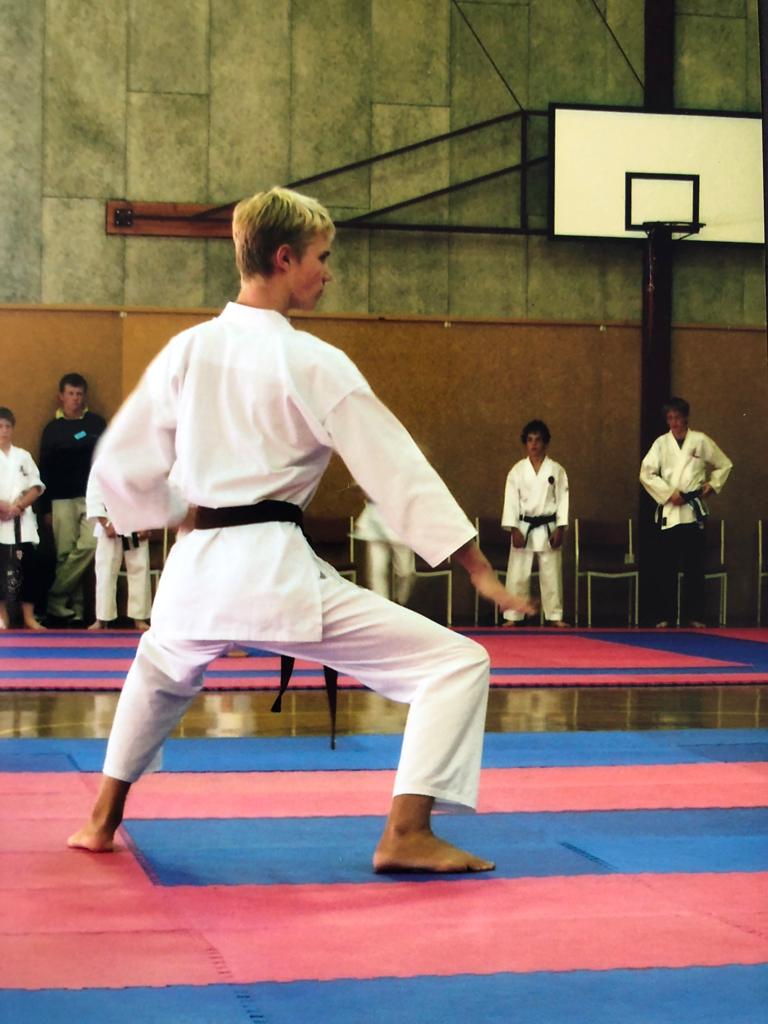
Van Halderen eventually received their first-degree black belt under Goju-Ryu Karate master Sensei Morio Higaonna who came to New Zealand from Okinawa to grade the students. They competed in tournaments and won some medals. Studying under Marrable and Morio stimulated Van Halderen’s interest in Japan. It would influence their decision to move there later and learn the language.
Learning karate also enabled Van Halderen to develop the physical confidence and agility that can be seen in Popcorn’s performances. “Karate really helped me to be comfortable in my body,” Van Halderen says. “I grew really tall quickly, and was very skinny and gangly with terrible skin for most of high school, so karate helped me to feel stronger and good at something. Having that ability to defend myself gave me a foundation of confidence when I really needed it.
The discipline underpins Van Halderen’s creative practice. “That physicality definitely still influences me today,” they say. “Using my limbs in a fast but controlled way, flipping onto the floor and jumping all over, and interacting very quickly with other bodies all really help in performance and dance. It’s definitely given me good physical control over my body and an ability to make unusual shapes in space.”
In 2009, Van Halderen moved to Wellington to study industrial design at Massey; his parents now live in the capital. In Wellington, they worked on a sustainable fashion project organized by UK researcher and activist Kate Fletcher. The other students were from Massey’s fashion department, but they wanted someone with an industrial design perspective so Van Halderen became the group’s fourth member.
“We did a lot of research, interviews, held lectures and events,” Van Halderen says. “We delved a lot into peoples’ attachment to their garments, why we choose to keep certain items and throw others away, and the economic practices that underpin the global fashion industry, which are terribly harmful. I still apply these ideas to my drag, recycling old items, using them many times in various forms, and making garments out of basically junk or detritus I find in Taipei.”
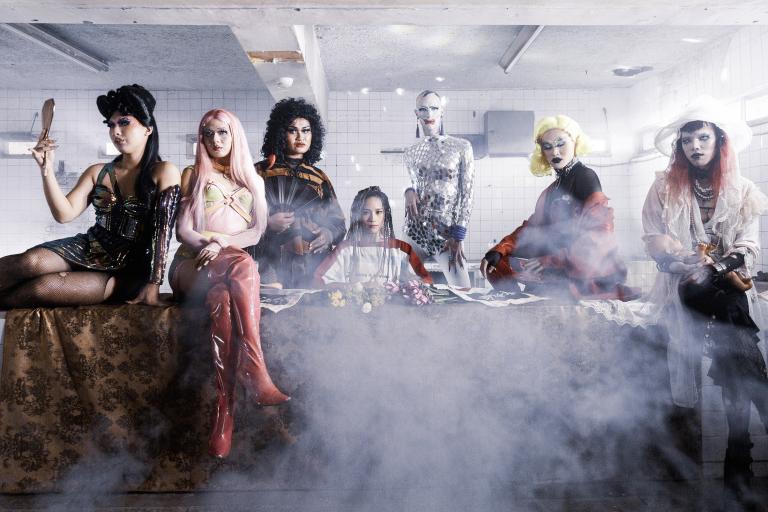
These days, Van Halderen is in a good place, enjoying married life in Taipei and Popcorn’s expanding profile. But in future, Van Halderen hopes they and Henry can be based between Taiwan and Aotearoa. They want to do more to connect their two homes. Perhaps some Popcorn performances in New Zealand could be on the horizon.
“I would love to visit and do a few shows and see how my style goes down with a Kiwi audience,” Van Halderen says. “I’m very conscious, though, that I’d be entering their world and their spaces, so I’d want to be respectful and do it in a way that compliments their way of doing things and the drag culture there. I'd need to communicate a lot with people there first. But it’s something I’d love to do.”
This article was commissioned by Asia New Zealand Foundation.
